








By Raheem Soto
If there’s one thing Tom Homan doesn’t do, it’s sugar-coat.
The former Acting ICE Director was in Albany recently, and he made it crystal clear—he’s had enough of the state’s sanctuary policies and the chaos they’ve created.
Standing alongside Republican lawmakers, Homan delivered a blistering critique of policies that he said are making New Yorkers less safe.
“These men and women standing behind the wire with some of the most dangerous people in this state should be honored and respected for the difficult job they do every day,” Homan said, throwing his support behind correctional officers struggling under the weight of a migrant crisis that’s only getting worse.
Continued on page 4






PUBLISHER
Diane Caudullo EDITOR-IN-CHIEF
Matt Meduri
STAFF
Cait Crudden
Raheem Soto ART
Sergio A. Fabbri
GRAPHIC
Colin Herr
CONTRIBUTORS
PJ Balzer
Ashley Pavlakis


Published by Messenger Papers, Inc.
Thursday, March 20, 2025
By Ashley Pavlakis
Do you ever just feel like dancing? The Arrowettes of Sachem North dance competitively at the varsity level in high school. The program has been successful for roughly twenty years, bringing home their seventeenth title in February at the National Dance Alliance competition in Orlando, Florida.
The Arrowettes are members of the New York State Public High School Athletic Association (NYSPHSAA). The squad is led by head coach Katie Desmond, who is in her twentieth season at Sachem North coaching varsity. Desmond graduated from the school in 2004 and practically waltzed right into coaching. She is joined by David Mackiewicz on the mat.
The Arrowettes compete in four styles of dance, jazz, pom, team performance, and kick.
“We get two routines choreographed by outside choreographers and then my other coach and I [David M] we choreograph two dances ourselves, which is nice. We teach them and we fix things throughout the season. We try to make sure we’re putting dances on the floor that showcase what we’re really good at. Just making sure the dances look polished, clean, and that their performance is really important. Their facial expressions, energy, and all those things we work on all season long,” said Desmond.
Dance is a unique sport and there are many factors that lead to performing a highquality routine. Desmond and her team are always practicing to get better.
“Locally, we did very well in terms of the competitions that we competed in on Long Island. Our team started competing in December about five times and we had a really good showing here. We kind of were able to carry that down to Florida where we competed at the NDA Nationals. We danced really well down there and ended our season on a really high note,” said Desmond.
The National Dance Alliance competition took place over Valentine’s Day weekend in Orlando. The Arrowettes took the floor against forty-two teams in the small poms division and danced nine times over the course of the weekend. Having secured first place in the preliminary round, they were able to bypass round two and go straight to the final.

“The last time we had won was 2022, so it was definitely a very rewarding win, we haven’t won in a few years. This was number seventeen for us in terms of national titles which is amazing and something we’re super grateful for. The category we won in, we’ve never won before which was pretty cool,” said Desmond.
If it’s not broken, don’t fix it. The Arrowettes were feeling good about themselves in the Sunshine State and kept it going all weekend long. Uniquely, their schedule on the final day had them competing three times in forty minutes. They rightfully earned their placements and weren’t going to change them just because of timing.
“Our pom theme was black and yellow, which are our school colors. I think it was just the routine that really stood out all season. We were undefeated on Long Island and then down in Florida it won every single time we competed with it this year,” said Desmond.
Desmond spoke about the group of dancers she had this season and how they work hard each day to continue on the legacy the team has built.
“They are such a good group of kids, we have fifteen girls and one boy this season and they’re so academic, and work really hard in school. They’re able to juggle our schedule with their dance teams. A lot of practice, especially when we get close to nationals, we end up adding a lot of practices just to make sure they’re as ready as possible,” Desmond told The Messenger.

Continued from front cover
Assemblyman Jarrett Gandolfo (R-Sayville), a vocal part of the press conference, echoed this sentiment. His words were not just a statement but a testament to the dedication of the Assembly and Senate members who are fighting for sanity in the state. Their commitment is unwavering, and they are not alone in this fight.
Gandolfo underscored the impact of New York’s sanctuary policies. These policies have funneled illegal immigrants into the state but have also fueled a crisis that has eroded public safety and cost the state billions. The gravity of the situation cannot be overstated, and action is needed now.
Gandolfo didn’t let Governor Kathy Hochul (D) off the hook either.

“She claims she would be the first to call for the removal of criminal illegal immigrants, but Director Homan, I doubt your phone has been ringing off the hook from Governor Hochul,” he quipped.
Despite the rhetoric, Hochul has left Executive Order 170—a sanctuary policy signed by former Governor Andrew Cuomo—firmly in place. Republicans, including Gandolfo, argue that she could repeal it with the stroke of a pen.
“She hasn’t, and she won’t,” he said bluntly.
To push back, Republicans have introduced Laken’s Law, a bill introduced by Gandolfo last year, which aims to:
1. Require law enforcement to notify ICE when illegal immigrants are arrested or released from incarceration.
2. Repeal the “Protect Our Courts Act,” which currently prohibits ICE agents from making arrests at courthouses.
3. Restore a maximum penalty of 365 days for Class A and unclassified misdemeanors, reversing a law signed by Cuomo that lowered the sentence to 364 days—an intentional loophole that prevents certain crimes from triggering federal deportation proceedings.
“We are talking about serious crimes here—sexual misconduct, resisting arrest, assault. Why are we protecting these individuals from deportation?” Gandolfo asked. “They should be the first ones removed from this country.”
Homan wasn’t just there to criticize New York. He took a flamethrower to former President Joe Biden’s (D-DE) border policies as well, touting President Donald Trump’s (R-FL) record in contrast.
“President Trump’s first-term success on the border was unprecedented. In just three weeks after returning to office, he achieved a 96% decrease in border crossings,” Homan said. “That means fewer women being trafficked, fewer children dying on the journey, fewer Americans dying from fentanyl, and fewer terrorists entering this country.”
He then laid out some shocking numbers. “Under Joe Biden, we had 400 people on the terrorist watchlist come across the border in four years. Under Trump, we had one.”
Homan also defended the Trump Administration’s push for a massive deportation operation, calling it essential.
“If we don’t enforce final removal orders, we send the message that illegal entry and ignoring federal law has no consequences,” he argued.
One of Homan’s biggest gripes is the Green Light Law which allows undocumented immigrants to obtain driver’s licenses and blocks ICE from accessing DMV records, making it nearly impossible to track down criminal illegal immigrants. He also railed against sanctuary cities that refuse to cooperate with ICE.
“Sanctuary jurisdictions are forcing ICE into the community to make arrests instead of allowing us to remove criminals directly from jails,” he explained. “That puts our agents and the public at greater risk. These policies shield dangerous individuals and make it harder to protect law-abiding citizens. It has to stop.”
Assemblyman Keith Brown (R-Northport) (pictured left) is also fighting for the passage of Laken’s Law and the removal of exemptions from the Green Light Law, which currently prevent law enforcement from utilizing the necessary resources to secure New York’s international border with Canada. Brown is bringing his expertise and Ranking Membership of the Committee on Alcoholism and Drug Abuse to specifically stop the flow and dangerous opioids into the country.

“In addition to stopping the flow of violence into our country, improving border security will help stop the flow of deadly fentanyl as well. The fentanyl epidemic has only been exacerbated by the migrant crisis and criminal organizations having unfettered access through the United States border, an epidemic which has claimed more than 313,761 American lives and 20,831 New York lives since 2020,” said Brown in a statement. “Special thanks to Border Czar Tom Homan for shedding light on the corruption
CreditOffice of NYS Assemblyman DeStefano
and disregard for public safety we have seen from the Biden Administration with regard to the migrant crisis nationwide. It is time for New York State to take the steps necessary to cooperate with federal immigration authorities to secure our nation’s borders and protect our citizens.”
As New York grapples with a migrant crisis that has overwhelmed resources and driven up costs, Republican lawmakers and border security advocates like Homan say they won’t stop pushing for change.
“We have to tear down these sanctuary policies, starting with the Green Light Law,” Gandolfo said. “The people of New York deserve better.”
“With the crisis at our nation’s borders worsening every day, New York must stop handcuffing law enforcement and start prioritizing public safety,” said Assemblyman Joe DeStefano (R-Medford) (pictured right) in a statement. “Our sanctuary policies do nothing but embolden illegal activity, endanger families and make it harder for law enforcement to do their jobs. The people of New York deserve leaders who will stand up for their safety and take action to secure our communities.”
Homan’s message was just as blunt: “If we don’t fix this, the crisis will only get worse. And trust me—everyday Americans are paying the price.”
For now, the fight continues, but one thing is clear—Homan and his allies aren’t backing down.
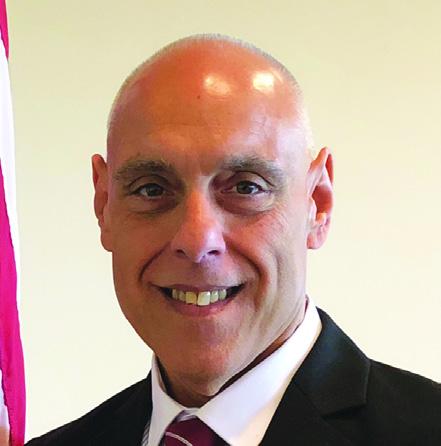

April 9, 1953 - January 16, 2025
The Tri-State Area mourns the loss of beloved transit expert and habitual newspaper letter-writer Larry Penner.
Born April 9, 1953, in Brooklyn, his family moved to Great Neck when he was six. He lived there his entire life, except for attending college at LIU-Brooklyn. He majored in political science and minored in history.
After taking over the mortgage for his parents’ house in Great Neck, he met his wife, Wendy, in 1994 at the Scobee Diner in Little Neck. They would go to the diner each year on the anniversary of their meeting and wait for the same booth. Wendy recounts

meeting Larry to screen him to set up a girlfriend with him, but she remarked that she knew he was hers from that day. Wendy recalls Larry bringing her flowers on the first date, a tradition he cemented going forward. Her coworkers would call him “the Rose Man,” as he brought roses to her office once a month. When Wendy stopped working, the monthly tradition remained. He continued the tradition throughout their entire marriage. They married in 1997. Larry, involved in Republican politics, ran unsuccessfully for an Assembly seat in 1980, which he parlayed into a 1981

political appointment in the Ronald Reagan (R-CA) Administration. He was appointed to serve in Region 2 of the Urban Mass Transit Administration (UMTA), now the Federal Transit Agency. He later earned a hired position in 1989 as a civil servant, culminating in his ascension to Region 2 Director, a position he held until he retired in 2010. He was in charge of approving government grants to various transit systems and authorities in New York City, Westchester, Connecticut, Buffalo, New Jersey, and Long Island.
A true transit man, he never had a driver’s license, relying solely on public transport his entire life.
At some point in the late 1980s, he had a letter to the editor published and it continued from there. When Larry and Wendy were married, Wendy was designated as his editor before he emailed them out. Wendy did so until his passing. Wendy has two or three bookcases full of notebooks that have plastic liners that have his letters and op-eds. One year, he had 700 letters published, a record.





Larry was also known to care for and even adopt stray cats throughout the neighborhood. Larry had never had a pet before meeting Wendy, who had three cats at the time.
Penner has also been noted for the somewhat ironic case of nominative determinism, in that his name lent itself to his passions and hobbies.
A true “penner,” and “Your Friendly Neighborhood Retired Federal Transit Man” – as he would sign his op-eds - Larry certainly never forgot to write.










Thursday, March 20, 2025
The Messenger learned of beloved historian, transit expert, and frequent letter writer Larry Penner’s passing in January. He was 71.
We always enjoyed receiving his frequent writings, usually his opinions and expert insight on transit issues plaguing the Tri-State Area. He held no punches, called balls and strikes, and was soberingly realistic on timetables for much-needed infrastructure overhauls.
Penner was also well-versed in small businesses, especially local diners and eateries. What separated his often-weekly submissions on transit was his advice to readers to support small businesses, take heed of the remembrance month at any given time, or even to encourage readers to patronize and write to their local papers.
Penner also offered his services to County Executive Ed Romaine (R-Center Moriches) upon the latter’s inauguration in January last year. Although Penner could not serve due to his residency in Nassau County, Romaine nonetheless gave him the time of day and even spent some time on the phone with him. Penner actually called our office to thank us for publishing the letter and to inform us of the Executive’s magnanimity.
Our conversation with his window, Wendy, gave us more of an insight into Penner’s life than we ever had behind the screen or over the phone. Her accounts tell of a classic gentleman, one who brought her flowers every month to her office, and continued the tradition at home when she stopped working. Moreover, the two would visit the now-closed Scobee Grill in Little Neck every year on the anniversary of
their meeting - and they would wait for the same booth if need be. The Penners were both known for their hospitality to local stray cats, often adopting them and caring for them over time.
But what makes Penner’s ubiquitous presence in the Tri-State Area even more ironclad is the outpouring of support from papers and news websites all across the region. All memorialized him, his expertise, his life of public service, and his kind heart.
Penner also frequently signed off his emails with the signature, “Your Friendly Neighborhood Retired Federal Transit Man,” a title of which we believe he is highly deserving. His letters amounted to seemingly-infinite levels, with Wendy informing us of his record of 700 in just one year, about two per day. What’s more, Wendy served as his proofreader and cataloguer from the beginning of his informal career as a letter writer until the end.
He certainly lived up to name as best as anyone could have.
So, to all of our readers, be not just a penner - don’t forget to write! - but also a Penner. We always encourage our readers to submit their thoughts - positive or negative - but from how his wife memorialized him, we’re comfortable in saying his path is one to be followed.
And one thing is for sure, he certainly never forgot to write.
The Messenger sends our condolences to the friends and family of Larry Penner. Attached is our last letter to the editor from him.
Dear Editor,
Congratulations to my fellow 2024 Letter-to-the-Editor writers. Surveys reveal that “Letters To The Editor” is one of the most widely read and popular sections of newspapers.
Most newspapers will print letters submitted by any writer regardless of where they live so long as the topic is relevant to readers. It helps to have a snappy introduction, good hook, be timely, precise, have an interesting or different viewpoint to increase your odds of publication. Papers welcome letters commenting on their own editorials, articles, or previously published letters to the editor.
I’m grateful that The Messenger affords both me and my fellow letter writers the opportunity to express our views, as well as differing opinions on issues of the day.
Please join me along with your neighbors in reading The Messenger. Patronize their advertisers; they provide the revenues necessary to keep them in business. This helps pay to provide space for your favorite or not so favorite letter writers.
Sincerely, Larry Penner
Long Time Reader and Frequent Letter Writer Great Neck
The recent report of the Town of Smithtown’s retention of the coveted Aaa (Triple-A) bond rating from Moody’s means the Town remains fiscally responsible with the correct levels of development that indicate future growth for small businesses and families alike.
However, while the Town has historically had high bond ratings, more lies within the numbers for accurate present context.
When Pat Vecchio (R) was Supervisor - the longest-served town supervisor or position-equivalent in the history of this country (he served forty years)the tail-end of his tenure was marked with recommendations from the Town’s comptroller to stop spending reserves. In the moves he made to not raise taxes - we can’t fault him for that - he created the possibility of a much larger problem and handed a somewhat dirty bomb to then-Councilman Ed Wehrheim (R-Kings Park), who would defeat Vecchio in a 2017 primary and would go on to win two full terms as Supervisor.
Vecchio’s padding of the operating budget from reserves meant that the Town’s credit rating would be downgraded after Moody’s implemented new performance metrics. Just as a good credit score can be harangued by lack of credit usage, the same goes for municipalities looking to bond.
While creditors can be predatory, it’s certainly a way of life that can be advantageous for the average consumer, but it’s often more than necessary to help a municipality - especially one in the State of New York - to break even, keep the lights on, and reinvest in town resources and infrastructure.
Although we can understand Vecchio’s core value of not raising taxes, the move set up the Town to exchange short-term popularity for long-term ambiguity.
People who are familiar with Smithtown know that the Town lagged behind others in terms of development, just now finally moving into the Twenty-First Century with proper sewer and wastewater systems being installed, core
downtown revitalizations in Smithtown, St. James, and Kings Park, and more streamlined Town services, such as applying for building permits online and more digital resources at the Clerk’s office - most are reasons for Moody’s stabilization of the Town’s de facto credit score.
Supervisor Wehrheim, in the view of The Messenger as well as many others, deserves the bulk of that credit. He inherited a town with parks in disrepair, virtually no sewer plans or implementation, a government-level lack of understanding of biodiversity, and aging infrastructure due to neglect.
A big problem: Vecchio’s obstinacy in refusing to bond out.
Because of the Town’s reaffirmed credit rating, bonding out capital improvements for pennies on the dollar on fixed ten-year bonds prevents the Town from dipping into reserves - a rainy-day fund, as it should be treated in most cases - and allows them to reap the benefits of a healthy bond rating should a much larger project be urgently needed.
All of this is to say, a bond rating is one thing, but if it’s not being used diligently and responsibly, the municipality will likely lag behind the world.
Smithtown was also just one of two towns - the other being Huntington - to not pierce their tax caps. A big problem that affects most municipalities in New York is the avalanche of unfunded mandates that typically apply to lower levels of government. As the Town relayed to us, it’s virtually impossible to maintain the Town’s resources and the State’s unfunded mandates on an operating budget alone, thus necessitating a good bonding ability.
We understand the struggles faced by other supervisors in Suffolk’s other eight towns; it’s not an easy time for most economically, but Albany certainly doesn’t make it easier.
But Wehrheim was able to navigate his own waters adeptly. In our opinion, any challenger or successor to Wehrheim will have to make a serious effort to set the bar higher.
March 20, 2025
By Dr. Laura Haydon PT, DPT, CLT
Lymphedema is a condition that causes swelling in parts of the body, most often the arms or legs. The swelling happens when the body’s lymphatic system, which is responsible for moving fluid throughout the body, doesn’t work properly. This leads to fluid building up in the tissues, causing uncomfortable swelling. Even though lymphedema affects millions of people, many don’t know much about it. Learning about lymphedema is important for helping people avoid it, catch it early, and find ways to treat it.
What is Lymphedema?
Lymphedema is when extra fluid builds up in parts of the body and causes swelling. This can happen in one arm, one leg, or even other parts of the body. People with lymphedema might notice that their skin feels tight, heavy, or hard. Sometimes, the swelling can make it harder to move the affected body part. If untreated, lymphedema can get worse over time and cause even more problems.
Signs and Symptoms of Lymphedema
Lymphedema can be tricky to notice at first because the symptoms can develop slowly. Some common signs to look for include:
• Swelling: This is the most obvious sign. One arm, leg, or other part of the body might swell more than usual.
• Feeling of Heaviness: The affected area might feel heavy or tight, like the skin is stretched out.
• Difficulty Moving: Swelling can make it harder to move the affected arm, leg, or body part.
• Skin Changes: In more severe cases, the skin may look thicker or even bumpy.
• Frequent Infections: Swollen areas can be more easily infected, which could lead to problems like redness or pain (cellulitis).
What Causes Lymphedema?
Lymphedema can be either primary or secondary, which means it can have different causes.
Primary Lymphedema
Primary lymphedema is rare and happens because the lymphatic system isn’t formed properly from birth. This can cause problems with draining fluid, which leads to swelling. Sometimes, this type of lymphedema shows up when someone is young, and other times it develops later in life.
Secondary Lymphedema
Secondary lymphedema is more common and happens because the lymphatic system gets damaged. There are several reasons why this can happen:
• Cancer Treatment: One of the most common reasons for secondary lymphedema is cancer treatments like surgery or radiation therapy. For example, many women who have breast cancer surgery might get lymphedema in their arm because the surgery or radiation can damage the lymph nodes.
• Vascular Disease: When the veins in the legs don’t work well, fluid can build up in the legs, leading to swelling. This is called venous insufficiency and is a common
cause of leg lymphedema.
• Injury or Infection: If someone injures their body or has a serious infection, it can also affect the lymphatic system and lead to lymphedema.
Why Is Lymphedema Awareness Important?
Early detection and treatment of lymphedema are very important. The sooner you notice the signs of lymphedema, the easier it is to treat and prevent it from getting worse. People who have had cancer treatments, especially breast cancer, are at a higher risk for lymphedema. It’s important for people in these groups to be aware of the symptoms and get checked regularly for any early signs of swelling. The earlier lymphedema is found, the easier it is to manage.
The best way to avoid serious problems from lymphedema is to get early treatment. Here are some important things people can do:
• Screening: People who have had cancer treatments should be regularly checked by their doctor for signs of lymphedema. This can help catch it early, so it can be treated before it gets worse.
• Education: Learning how to recognize the signs of lymphedema is very important. Patients need to know how to take care of their bodies and reduce the chance of fluid building up. Simple steps like gentle exercise, wearing compression garments (special sleeves or stockings that help with swelling), and keeping the skin clean can help.
• Complete Decongestive Therapy (CDT): If lymphedema does develop, a special treatment called Complete Decongestive Therapy (CDT) is used. CDT includes exercises, manual lymphatic drainage (a type of massage to move fluid), wearing compression garments, and taking care of the skin.
At Haladay Physical Therapy, we specialize in helping people with lymphedema. Our team is trained to diagnose, treat, and manage lymphedema in all of its stages. We provide personalized treatment plans that include techniques like CDT to reduce swelling and improve quality of life. We also educate patients on how to maintain their health and prevent lymphedema from getting worse.
It’s very important for everyone to know about lymphedema, especially if they have had surgery, radiation, or other cancer treatments. Being aware of the signs of lymphedema and getting regular check-ups can help catch it early. Once lymphedema is caught, it can be treated, and the swelling can be reduced.
If you or someone you know is dealing with lymphedema, don’t hesitate to reach out for help. At Haladay Physical Therapy, we are here to guide you through treatment and help you manage the condition. Together, we can improve your health and help you feel better.
By learning about lymphedema, we can all take steps to prevent it and make sure people get the care they need. Early action, education, and treatment can make a big difference in the lives of people with lymphedema.
By Assembly Minority Leader Will Barclay
The full extent of the impacts to New York state from the unprecedented migrant crisis is still being measured. Four years of open border policies and millions of undocumented individuals entering the country took a heavy toll. Even now, as President Donald Trump (R-FL) and his administration prioritize identifying and fixing the problems, we have a long way to go before this damage is undone.
The Assembly Minority Conference this week reinforced our call to finally restore order and advance legislation that directly addresses New York’s misguided sanctuary status that turned the state into a prime destination for illegal immigrants. We were fortunate to be joined by ‘Border Czar’ Tom Homan, a native New Yorker who served as the acting director of U.S. Immigration and Customs Enforcement (ICE), to lend his insights and share his experiences.
Our message is simple: bring back collaboration between local agencies and federal government partners to clean up this mess.
We hope to accomplish this with two pieces of legislation: “Laken’s Law,” named after twenty-two-year-old nursing student Laken Riley, who was tragically murdered by an undocumented Venezuelan migrant who was previously arrested and released in Queens, and a repeal of the state’s Green Light Law in counties around our northern border, which grants driver’s licenses to undocumented individuals and prohibits the Department of Motor Vehicles from sharing information with federal immigration officials.
As I stated during our press conference, public safety should not be a matter of partisan politics. The opposition to these proposed changes coming from Governor Kathy Hochul (D) and her legislative allies is frustrating. Rhetoric
about opening the border for humanitarian purposes has been exposed tenfold for what it is, a political ploy and an excuse to waste taxpayer money with service providers that consistently failed to do their jobs. These policies greatly diminished the quality of life and safety of both migrants and legal residents, and one need only look at the shape New York City is in for proof.
Mr. Homan’s presence at the Capitol triggered the typical hysterics from the out-of-touch liberals, who held not one, but two, panicked press conferences to “respond” to the Border Czar’s visit. Having apparently learned nothing from national elections, they remained steadfast in their defense of sanctuary policies that helped get Mr. Homan’s boss elected last November.
The governor and legislative Democrats have continued to show they are more concerned with obstructionist governance than problem solving. I implore them to reverse course and restore cooperation with ICE and other federal law enforcement agencies. New Yorkers should no longer have to subsidize an immigration policy that compromises their own safety, and they never should have been forced to do so in the first place.
If you have any questions or comments on this or any other state issue, or if you would like to be added to my mailing list or receive my newsletter, please contact my office. My office can be reached by mail at 19 Canalview Mall, Fulton, NY 13069 and by email at barclayw@nyassembly.gov. You may also find me, Assembly Minority Leader Will Barclay, on Facebook or Twitter at @WillABarclay.
Assemblyman Will Barclay (R-Pulaski) is the Assembly Minority Leader and has represented the 120th Assembly District since 2003. The 120th District contains most of Oswego County and parts of Jefferson and Onondaga counties.
By Raheem Soto
New York’s prison system is in chaos, and State Senator Dean Murray (R-East Patchogue) says Governor Kathy Hochul (D) is making it worse.
After more than 2,000 correctional officers participated in a twenty-two-day wildcat strike to protest dangerous working conditions, the governor responded with mass firings—permanently blacklisting them from any future state employment.
Murray, who has been outspoken on the prison crisis, says the move was “nothing but being vindictive” and is now calling for federal intervention, even reaching out to former President Donald Trump (R-FL) to help fix the problem.

The crisis started with the Humane Alternatives to Long-Term (HALT) Solitary Confinement Act, which severely limits solitary confinement in New York’s prisons. Murray argues that this policy has emboldened violent inmates and stripped correctional officers of essential tools to maintain order.
“The HALT policy basically eliminated all forms of solitary confinement or segregation of prisoners,” Murray told The Messenger. “That has taken away a tool in the tool belt of corrections officers for disciplinary measures.”
Without solitary confinement as a deterrent, Murray says bad actors inside prisons know they can get away with violence.
“They seem to have taken everything away that serves as a deterrent for prisoners acting out—either attacking or committing other bad behavior that hurts corrections officers, prison staff, or even other inmates,” he said.
With violence in New York State prisons skyrocketing, correctional officers say they’ve had enough. Many have been forced to work mandatory double and even triple shifts, sometimes staying inside for forty-eight hours straight due to staff shortages. Their frustrations reached a boiling point, and they walked off the job in an illegal strike.

Governor Hochul (pictured below) responded by ordering them to return to work or face termination. When they refused, she fired over 2,000 correctional officers and banned them from working for any state agency in the future.
Murray says this decision will only make things worse.
“It’s a punishment, but an unnecessary one,” he said.
“The reason they walked out is because they had no other alternative. They reached a point where they felt it was so dangerous in the prisons that they had to take drastic measures to get someone to listen.”
While the walkout violated the Taylor Law, which prohibits public employees from striking, Murray argues that Hochul’s response was extreme.
“At some point, and I don’t necessarily condone doing that, but at some point, you reach a level where you say, ‘We have to do something,’ and they reached that point,” he said. “I understand where they were coming from, and I don’t believe those 2,000 should have been fired—or banned from working for the State.”
With thousands of trained officers gone, Hochul deployed the National Guard to staff the prisons. But Murray says this is not a real solution.
“These are not trained corrections officers,” he said. “This was supposed to be a stopgap measure to ensure prisoners were being fed, housed properly, and that things were kept orderly. It was supposed to be temporary.”
Murray says it’s looking more permanent—and that’s a major problem.
“The governor just made the staffing crisis worse by firing 2,000 officers,” he pointed out. “How does that help with hiring, recruiting, and retention? It’s a step in the absolute wrong direction.”
Murray is now calling for the federal activation of National Guard members inside prisons under Title 10, which would shift them from State control to federal oversight.
“Right now, the State has to absorb all the costs,” he explained. “If they are federalized, the federal government picks up the cost, and that would save us millions and millions of dollars each month.”
Beyond saving money, Murray says it would improve conditions for the National Guard members themselves.
“They would have better protections, better benefits, and better coverage if they were nationalized or federalized,” he said. “And something most people don’t even realize—right now, their prison duty does not count toward their required active-duty service. If we federalized them, it would.”
It’s not just correctional officers and lawmakers speaking out. Even the families of incarcerated individuals are starting to push back against the HALT Act.
“Inmates are saying, ‘We want that [solitary confinement] because in some cases, you’ll have an inmate in the general population who might be in danger,” he said. “They may have helped give information to corrections officers, or there might be
gang tensions. They want to be segregated for their own protection, but they can’t do that now—not with HALT in place.”
Murray urged concerned families to keep speaking out, especially as violence inside prisons continues to rise.
Meanwhile, legislative efforts to repeal the HALT Act were blocked in the Senate despite growing support for its reversal. Senator Dan Stec (R-Queensbury) proposed a repeal, but Democratic leadership refused to bring it to a vote.
In addition, the union representing the fired correctional officers has filed lawsuits, arguing that the firings violated collective bargaining agreements. They are demanding reinstatement and restoration of health benefits.
Murray (pictured right) remains skeptical about Hochul reversing her decision.
“Firing 2,000 corrections officers is a step in the wrong direction,” he said. “That was more vindictive than anything else.”

With the prison crisis deepening, Murray and other lawmakers are pushing to reverse the HALT Act and address the staffing shortage. Whether Hochul will budge remains unclear.
But Murray says one thing is certain: the way this was handled will come back to haunt her.
“This was handled so incredibly poorly,” he said. “She took a bad situation and made it worse.”
For now, correctional officers, inmates, and their families are left waiting— wondering if safety and order will ever return to New York’s prisons.
This is a developing story.





















By Matt Meduri
Congresswoman Elise Stefanik (R, NY-21) appears to be moving out of an effective purgatory in the U.S. House, as the Senate has set a date for her confirmation hearing to be President Donald Trump’s (R-FL) United Nations Ambassador.
Stefanik is the sole remaining Cabinet or Cabinet-level nominee that has not been confirmed. All of Trump’s picks have been confirmed thus far.
Republicans have slow-walked Stefanik’s confirmation hearing to preserve their bare-minimum 218-seat majority. Democrats sit at 213 seats after the recent passings of Congressmen Sylvester Turner (D, TX-18) and Raúl Grijalva (D, AZ-07).
Republicans, meanwhile, currently lack two seats of their 220-seat majority they won in 2024, due to the appointment of former Congressman Michael Waltz (R, FL-06) as National Security Advisor and the resignation of Matt Gaetz (R, FL01) after he was selected as Trump’s Attorney General pick. Both seats are expected to stay in Republicans hands; special elections are scheduled for April 1.
Confirming Stefanik at the present moment would create a problem for Speaker Mike Johnson (R, LA-04), who needs every vote possible to pass the agenda of Trump and the GOP.
Stefanik’s confirmation is scheduled for April 2. Stefanik’s nomination was advanced in January by the Senate Foreign Relations Committee to the tune of a19-3 vote. Stefanik earned the support of seven Democrats.
On the other hand, Governor Kathy Hochul (D) and the Democraticled State Legislature might stage a slow-walk of their own, with the possibility of them reintroducing legislation to set the special election until November. The move would leave the North Country seat that Stefanik flipped in 2014 vacant until January 2026.
The system has received a score of 134 on the Outbreak Intensity Scale (OIS), categorizing the storms as “historic.”
Governor Kathy Hochul (D) has remained defiant of a Trump-mandated Friday, March 21, deadline to rescind congestion pricing.
Hochul met with Trump in the Oval Office in February, attempting to pitch him the reasons for the congestion toll that charges drivers traveling south of 60th Street. During her press conference at Islip MacArthur Airport (ISP) last month, Hochul told The Messenger that the toll has worked to free up parking spaces, increase public transit use, and allow cab drivers the ability to make fares not only faster, but also easier.
Contrariwise, critics say that the plan punishes those for living and working in the city, with labor unions especially concerned about regular expenses that, while small at face value, add up over time.

In other political news, President Trump is dusting off old confidants to oversee various military academy boards after purging the boards of their incumbents in his endeavor to overhaul the military.
Former National Security Advisor Michael Flynn (R-RI) has been tapped by Trump to sit on the U.S. Military Academy Board of Visitors, along with Congressman Wesley Hunt (R, TX-38) and Maureen Bannon, a West Point graduate and daughter of firebrand conservative Steve Bannon.
Flynn, a retired lieutenant general, served as Trump’s National Security Advisor for about the first month of his first term. He resigned after concerns about his alleged obfuscation of contacts with the Russians. In his resignation letter, he claimed he “inadvertently briefed the Vice President-Elect [Mike Pence (R-IN)] and others with incomplete information” regarding his calls with the Russian Ambassador.
The Air Force’s Board of Visitors has been filled with Senator Tommy Tuberville (R-AL) and Charlie Kirk, founder of conservative network Turning Point USA, among others.
The Naval Academy’s Board of Visitors will see the appointment of another early-Trump 1.0 official, Sean Spicer, who served as Trump’s first Press Secretary from January to July of 2017. The Naval Academy’s board will also see Senator Tim Sheehy (R-MT) and Congressman Ronny Jackson (R, TX-13), who served as White House Physician to presidents Barack Obama (D-IL) and Trump. The boards serve more as advisory panels that have a say in curriculum, finances, and other pertinent matters.
In other national news, a severe tornado outbreak tore across more than a dozen states over the weekend into Monday, producing peak winds of 190mph and leaving forty-two people dead as of press time.
The system produced at least 102 tornadoes, with Oklahoma, Mississippi, Alabama, and Missouri seeing some of the most significant damage.
The system also produced violent dust storms that claimed eight lives in a multi-vehicle collision on I-70 in Kansas.
Metropolitan Transit Authority (MTA)
CEO Janno Lieber, who has served in that capacity since 2022, said that the cameras will stay on after March 21, as long as the MTA’s lawsuit challenging the U.S. Department of Transportation’s efforts to end congestion pricing remains active.
The first-in-the-nation toll program of this caliber has been largely unpopular, although Hochul claims that she and Trump agree on revamping Penn Station and the subway system.
Hochul also mentioned that Trump appeared to have expressed dismay at the $6 billion price tag of the Penn Station renovation.
“I don’t take that as a ‘no,’” said Hochul. “We are doing Penn Station. I’m supposed to show him the plans. That will be my next trip down.”
The New York Post reports that within the first month of the plan, the MTA raked in $48.7 million in revenues, 68% of which was substantiated by passenger vehicles. Taxi and for-hire rides made up 22%, with trucks making up 9%, and buses and motorcycles making up just 1%.
Hochul also showcased a picture book that she tried to use to convince Trump to change his mind on the toll.
“I said, ‘I want something that encapsulates, in real simple terms, real nice pictures, what we’re getting with congestion pricing,’” said Hochul. “So, I was able to show this to the President behind his desk and talk about how beautiful it is.”
Hochul made specific references to the “big words” and “nice colors” at February’s MTA board meeting at Grand Central Madison. One phrase is reported to have read “big, beautiful Penn Station,” likely a method of appealing to Trump in his trademark conversational hyperbole.
Meanwhile, Hochul continues to face resistance to another goal, that of her plan to ban phone use in schools.
While many have agreed that phone usage in schools is distracting and removes the impetus to stay engaged, the detractors have proposed alternative approaches, often scaled-down from her proposed statewide, no-tolerance ban.
during instructional hours. The Assembly, on the other hand, left the bill out of its one-house proposal altogether.
A coalition of school districts is also supporting an alternative bill that would let individual school districts decide whether to ban phones during instructional and non-instructional periods, such as homeroom and lunch.
“I’m not going to compromise our children’s health,” Hochul said. “And that means I am fighting for a full, allday-long, bell-to-bell, distraction-free environment.”
The budget is due on April 1, the start of the state’s fiscal year. The State’s first on-time budget in years was 2025’s, passing at the tail-end of March. New York budgets are no stranger to being delayed, with the 2023 budget having been finalized in May of that year. Since the 1980s, New York’s budgets have been regularly delayed.
Suffolk Republicans have locked down their first win of the 2025 election year and the first special election thus far.
Former Town Councilman Richard Martel (R-Hampton Bays) (pictured below) defeated John Leonard (D-Hampton Bays), who serves on the Town’s Board of Zoning Appeals, to fill the open seat of former Councilman now-Assemblyman Tommy John Schiavoni (D-North Haven).
Martel served on the Town Board from 2020 until his reelection loss in 2023.
Martel staged a comeback to the tune of a six-point win - 52.9% to 46.8% - with unofficial tallies showing Martel with 3,092 votes to Leonard’s 2,738. Martel will have to defend this seat again in the November general election.
Southampton elects its Town Board in an at-large fashion in which the entire town votes, as opposed to the councilmanic district method seen in Brookhaven and Islip.
Southampton’s politics are relatively textbook, typically utilizing the Shinnecock Canal as the delineator between a more red-leaning, working-class western Southampton, and a more affluent, liberal eastern Southampton.
Leonard’s strength came from the eastern part of Southampton, easily eclipsing 60% of the vote in places like Sag Harbor, Sagaponack, Shinnecock Hills, Southampton Village, and Bridgehampton.
Leonard narrowly edged Martel in Water Mill, while Martel narrowly edged Leonard in a Southampton Villagebased precinct. The two candidates are virtually tied - or literally tied in some cases - in areas like North Sea, Tuckahoe,

Hochul proposed the initiative in her January Executive Budget, part of her $252 billion spending package. The bill would have also freed up $13.5 million to be available to schools to purchase and install lockers or other storage equipment.
Like other parts of the executive budget, the plans would have to be approved separately by the two chambers of the legislature - they’re appropriately called one-house budgets. The Senate proposed a scaled-back version of the plan that only required school districts to prohibit smartphone usage
Martel cruised to victory in reliably-red precincts west of the canal, including Flanders, Squiretown, Eastport, and parts of East Quogue and Hampton Bays.
Leonard’s strong suits in the western part of town were also typical for a Democrat, notching decent wins in Northampton, Riverside, Quiogue, and Quogue.
“Today, Republicans from throughout Suffolk came together to elect Rick Martel to the Southampton Town Board, a major victory and a sign that the Republican momentum of triumphs by County Executive Ed Romaine (R-Center Moriches), District Attorney Ray Tierney (R), and President Trump has reached all the way to the East End of Suffolk County,” said Suffolk County Republican Committee Chairman Jesse Garcia (R-Ridge) in a statement. “The significance of this Republican victory in an area dominated by Democrats really cannot be overstated. The Republican promise of building a safer, secure and more affordable Suffolk County resonates with every voter.”
In his statement, Garcia thanked the “tireless work” of party volunteers who went “street by street and home by home” across Southampton to urge voters to elect Martel. “Clearly, the Suffolk County Republican momentum has not slowed down, and today it rolled all the way to Southampton,” said Garcia.
Martel joins Councilmembers Michael Iasilli (D-Pine Neck), Cynthia McNamara (R-East Quogue), and William Pell IV (D-Southampton) on the Town Council. Maria Moore (D-West Hampton Dunes) serves as supervisor.
By Matt Meduri
In an effort to boost local economies and tourism, but also to reap the near-infinite perennial benefits of living directly on coastal waterways, New York State’s Department of Agriculture officially opened the Long Island Seafood Cuisine Trail at the Snapper Inn in Oakdale on Wednesday afternoon.
The trail is part of Governor Kathy Hochul’s (D) Blue Food Transformation Initiative, first unveiled during the 2024 State of the State Address. The effort has been collaborative between Agriculture, the Cornell Cooperative Extension of Suffolk County, and other players.
The project also includes $5 million in infrastructure funding to bolster local aquaculture.
Keri Blanchard, general manager of the Snapper Inn and fourth-generation Remmer family member, who owned and operated the establishment for ninety-six years, says the Inn’s participation on the trail continues the legacy of her predecessors.

“Since the day we opened in 1929, we have been dedicated to serving fresh-caught Long Island seafood, and it is our honor to continue that tradition as we kick off this incredible initiative,” said Blanchard.
As of now, the route includes twenty locations and begins at Salt & Barrel in Bay Shore and ends in Montauk, with the Snapper Inn being the third destination on the eastbound route, behind The Lakehouse in Bay Shore. The route then continues to Blue Island Oysters in West Sayville, The Cull House in Sayville, and The Fish Store in Bayport.
Into Brookhaven Town, the next stops are Shands General in Patchogue, followed by Varney’s Restaurant in Brookhaven hamlet, and Mastic Seafood in Mastic.
Into Southampton Town, the route continues to Haskell’s Seafood Market and Cafe in Westhampton, followed by Lighthouse Seafood in Hampton Bays. Clamman in Southampton Village picks up the route across the Shinnecock Canal, along with two destinations to the north bordering the Great Peconic Bay: Captain Jack’s on the Coast in North Sea and Bell and Anchor in Noyac. The last Southampton stop is Almond in Bridgehampton.
Finally, East Hampton Town is home to five locations: The Seafood Shop in Wainscott; Nick and Toni’s and Bostwick’s Seafood Market, both in East Hampton North; and Montauk Seafood Company and Inlet Seafood, both in Montauk.
“New York ranks in the top-ten in over thirty different commodities, so we figure in every national conversation about agriculture,” said NYS Agriculture Commissioner Richard Ball (pictured right). “[Seafood] is a way of life on Long Island. You’ve been at the front of the Eat Local movement and local food for centuries.”
Ball, a vegetable farmer in Schoharie, understands not only the needs of agricultural communities, but also the synergies between various subsets of the industry.
The Long Island Oyster Growers Association is also eager about the trail, with President Eric Koepele (pictured right) serving up oysters for the tasting after the press conference. Koepele has been running North Fork Big Oyster in Mattituck for four years.
Koepele opened by invoking the classic Intel jingle, which quickly branded the company as the leader in the microprocessor industry.
“The Seafood Trail is just another manifestation of an ingredient campaign and it’s especially clever because food, of course, would be an ingredient this time,” said Koepele, referencing a classic ingredient campaign, a marketing strategy in which a company promotes a specific component - or “ingredient” - of their product as a key selling point.
“My vision for the farms here around the island is to get the members of the association to up our output from currently about 10 million oysters a year to 100 million in ten years. I think if we hit 100 million, we become a meaningful force in the industry. 100 million happens to be roughly the number of oysters that Canada sends down to the U.S. every year,” said Koepele. “100 million also happens to be the number of oysters that the Chesapeake grows and harvests every year. So we put ourselves on par with some of the biggest producers in the world and some of the biggest producers on the East Coast. We could hit that number and the good news is we’re tracking to do that.”

“The idea of the Blue Food Transformation Initiative was to invest in agriculture and reinvigorating New York’s wild-caught seafood and aquaculture industries,” said Ball, adding that New York “learned some things” during the COVID-19 Pandemic. “New York better have a resilient food system, a responsive food system. Let’s not depend on food from another region, another country.”
Ball continued by saying that the trail will not only “boost” the seafood industry, but will help the farmers as well as local tourism. The department is also working on a mobile app to complement consumers’ and travelers’ trail-chasing seafood experience.
Vanessa Lockel, Executive Director of the Cornell Cooperative Extension at Suffolk County (CCE Suffolk), said that the initiative, while welcomed at face value, marks a new era for the South Shore, particularly after areas like the Snapper Inn in Oakdale were underwater after Superstorm Sandy.
“The CCE Suffolk Marine Program plays a key role in preserving Long Island’s waterways through science, restoration, and education,” said Lockel. “We are proud to have partnered on the Long Island Seafood Cuisine Trail, a project that aligns with our mission by highlighting the region’s aquaculture and seafood industries— industries that are critical to both our economy and the health of our environment.”
Lockel added that small businesses reliant on marine resources generate nearly $55 million annually.
“We surveyed hundreds of restaurants, fish markets, and different locations on Long Island to try to get as much feedback as we can and find out where we should focus on and celebrate local seafood,” said Kristin Gerbino, Fisheries Specialist at CCE Suffolk, described by Lockel as the “boots-on-the-ground” element of the seafood trail. “We’re on an island surrounded by all this delicious, fresh fish, and oysters… But I think we’ve done a super job of coming up with twenty high-quality locations along the trail that we’re really, really excited for and proud to promote and share this opportunity with everyone.”
The Long Island Farm Bureau is also a beneficiary of aquaculture, with bureau President Juan Micieli-Martinez on hand.
“As a kid, I fished in our local ponds, clammed and caught blue claw crabs in our bays, went out on fishing charters and surf casted in the Atlantic and Sound. I know firsthand the delicacies that come from these waters. Commercial fishing, shellfishing, and aquaculture are legacy industries on Long Island and it’s great to see the rejuvenation of these industries,” said Micieli-Martinez. “Local aquaculture and fishing products have better flavor and are more sustainable.”
As a winemaker in Riverhead, Micieli-Martinez informed the public that local shellfish and seafood pair “incredibly well” with local wines.
Koepele also shared that the State Department of Environmental Conservation (DEC) reports that in the past ten years, there hasn’t been a single illness outbreak among humans that’s been associated with eating oysters.
“We’ve got some of the safest oysters in the world coming out of our waters here,” said Koepele, before quipping, “Queen Victoria mandated nothing but Long Island oysters in Buckingham Palace.” Discover Long Island (DLI) also plays a component in connecting the transit and tourism component of the trail. DLI is the only accredited destination marketing organization in the Long Island region, and the official tourism promotion agency for Suffolk County.
“[The Seafood Trail] is a brand-new product and attraction for our 42 million visitors that come every year to Long Island and support our $7.5 billion tourism industry,” said DLI President and CEO Kristen Reynolds (pictured right), adding that Farmingdale will play host to the 2025 Ryder Cup golf tournament.
“We’re going to have 250,000 people from around the globe, and they don’t know what the Snapper Inn is - and it’s not exactly right off the Expressway. Having a product like this, it connects seamlessly, and through modern technology, which allows our visitors to find what they crave.”

Islip Town Supervisor Angie Carpenter (R-West Islip) offered supportive sentiments in a statement: “Long Island’s waterways are one of our greatest natural resources, and initiatives like the Seafood Cuisine Trail not only celebrate our longstanding maritime heritage but also support the hardworking individuals who sustain our local seafood industry. Through our Town’s Shellfish Hatchery initiative, we are committed to protecting water quality, replenishing shellfish populations, and ensuring that locally harvested seafood remains a cornerstone of our economy and culture. I’m proud to stand alongside so many dedicated partners today as we continue working toward a thriving, sustainable future for Long Island.”
Assemblyman Jarett Gandolfo (R-Sayville) offered his support in a statement: “Long Island’s seafood industry isn’t just a key part of our local economy, it’s part of who we are. From family-owned restaurants to hardworking fishermen, so many livelihoods depend on a thriving aquaculture industry. The launch of the Long Island Seafood Cuisine Trail is a great way to highlight and support these businesses while also giving residents and visitors the chance to experience the incredible seafood our waters provide. Investing in our local seafood industry means protecting jobs, strengthening Long Island’s tourism, and preserving a tradition that has been passed down for generations. I’m genuinely excited to see this take off and be able to see the positive impact it will have on our community.”

While the Seafood Trail will certainly be a point of force this summer, what’s more - the people behind this trail are already looking at a similar trail for the North Fork.
By Cait Crudden
Congressman Nick LaLota (R-Amityvile) has reaffirmed his commitment to responsible governance by voting in favor of the Full-Year Continuing Appropriations and Extensions Act, 2025. This measure keeps the federal government funded through September 30, 2025, ensuring continuity in essential services while preventing a shutdown that could impact millions of Americans.
LaLota emphasized his dedication to fiscal responsibility, military personnel, and essential social programs while criticizing House Democrats for their lack of bipartisan cooperation.
“This week, I proudly voted to keep our government open, cut wasteful spending, protect Social Security and Medicare, and deliver the largest pay raise ever for junior enlisted troops. While I’m disappointed that nearly every House Democrat voted no—after Republicans like me voted to fund the government under President Biden (D-DE)—I remain committed to working across the aisle to do what’s right for Long Island families,” LaLota stated.
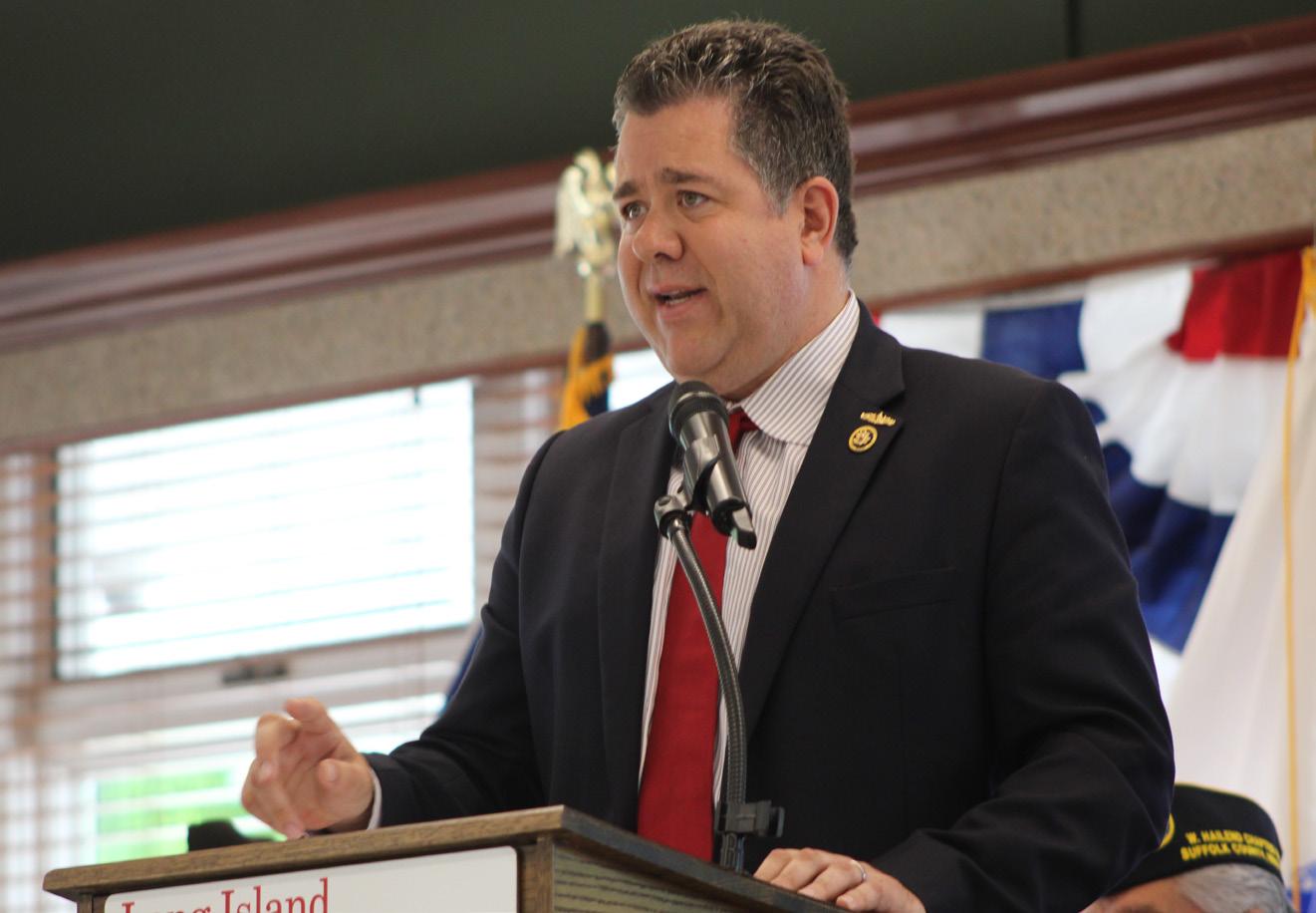
While LaLota praised the passage of the funding bill, he also underscored the need for continued budget discussions to address additional economic concerns, particularly the State and Local Tax (SALT) deduction cap that disproportionately affects Long Island homeowners.
“Congress needs to cut spending to fight inflation, secure the border, and protect future generations, all while safeguarding the benefits our seniors and veterans have earned. And I’ll keep fighting to get Suffolk County its SALT relief for middle-class families when budget talks resume later this year,” LaLota said.
As government funding remains secure, LaLota’s efforts to balance fiscal conservatism with essential federal support continue to shape his legislative priorities. His vote stands as a testament to his commitment to his constituents, military personnel, and veterans while striving for economic stability and security.
Some of the key provisions of the Continuing Appropriations Act are Defense and National Security. This ensures the full funding of the Department of Defense, increasing the general transfer authority from $6 billion to $8 billion, providing the largest junior enlisted pay raise in over forty years, the most significant increase since the Reagan Administration and supporting new defense projects and maintaining ongoing procurement efforts crucial to national security.
The bill also included Veterans’ healthcare and benefits, protects funding for Veterans’ medical services, pensions, and housing programs. It also allocates an additional $6 billion for the Toxic Exposures Fund, aiding veterans affected by hazardous service-related conditions.
For Medicaid and Medicare, the bill delays Disproportionate Share Hospital (DSH) cuts until April 1, 2025, with reductions phased in from FY 2026 through FY 2028, extends critical Medicare programs, including: lowvolume hospital payment adjustments, Medicare-Dependent Hospital (MDH) program, telehealth flexibilities to ensure access for seniors and rural communities, and increases the Medicare Improvement Fund from $1.251 billion to $1.804 billion.
Nutritional Assistance and Social Programs will continue with the bill fully funding SNAP (Supplemental Nutrition Assistance Program) and WIC (Women, Infants, and Children nutrition assistance), increasing WIC funding by over $500 million, bringing the total to $7.6 billion, and maintaining funding for Temporary Assistance for Needy Families (TANF) to provide financial aid to struggling households.
Disaster Relief and Infrastructure were addressed as well. It will continue support for FEMA’s Disaster Relief Fund, including a $115 million repurpose of funds from the Infrastructure Investment and Jobs Act (IIJA), and extend the National Flood Insurance Program (NFIP) through the fiscal year to prevent coverage disruptions for homeowners.
Homeland Security and Border Management will fully fund Customs and Border Protection (CBP), Immigration and Customs Enforcement (ICE), and the Transportation Security Administration (TSA), provide funding flexibility for Coast Guard personnel and disaster response efforts.
Public Health and Research will extend funding for community health centers, the National Health Service Corps, and critical medical research programs, as well as support the Special Diabetes Program and National Institutes of Health (NIH) initiatives.
LaLota has consistently opposed government shutdowns, advocating for responsible spending while maintaining essential services. In December 2024, LaLota voted for the American Relief Act to keep the federal government funded through March 14, 2025. In January 2025 and October 2023, LaLota introduced the Troops Before Politicians Act, which mandates that Members of Congress forfeit their pay when military pay is suspended due to budget disputes. During the 118th Congress, he co-sponsored the Prevent Government Shutdowns Act, which would require lawmakers to remain in Washington, D.C., and finalize spending bills before recess.
Congressman Nick LaLota’s support of the Full-Year Continuing Appropriations and Extensions Act ensures that vital federal services remain operational, protect military funding, and upholds critical social programs. As Congress continues budget discussions, LaLota remains a staunch advocate for responsible spending and policy solutions that benefit Long Island families and the nation as a whole.

Thursday, March 20, 2025
Members of the Hauppauge-Smithtown girls’ swim team were recently recognized at the Suffolk County Legislature’s general meeting with a proclamation for winning the Suffolk County Championship for the fourth consecutive year and the New York State Championship for the second time in three years.
Each member of the team received a certificate, and the team was presented with a proclamation recognizing their many successes.
Among their successes, Hauppauge-Smithtown’s 200 freestyle relay team of Julia Lucca, Olivia Chiofolo, Avery Wilcox and Sarah Lucca were state champions and set a new Suffolk County record with a time of 1:35.79. Hauppauge-Smithtown’s 200 medley relay team of Julia Lucca, Schroeder, Sarah Lucca and Olivia Chiofolo were state champions with a time of 1:45.01. This was an All-American consideration time.
Hauppauge’s Mackenzie Clarke was the 2024 Lester Schloan Jr. Award winner, which is given to the most promising first year diver. The Hauppauge-Smithtown coaching staff of Rich Lionetti, Brandon Modrov, Sean Montalvo, and Kurt Margraf won the Ed and Alice Kropp Coaching Staff of the Year Award.

Brentwood High School welcomed New York State Education Department Commissioner Dr. Betty Rosa on March 8, as she and some of the state’s top education officials toured the district’s new GraduationPlus+ initiative. The program provides students with early college credit opportunities and hands-on career experiences, ensuring they graduate with the skills needed for success in higher education and the workforce.
“It was an honor to welcome Dr. Betty Rosa and her esteemed team to witness firsthand the transformative impact of the Graduation Plus+ initiative and the incredible opportunities we are creating for our students,” Superintendent Wanda Ortiz-Rivera said. “This visit reaffirmed that Brentwood is not just preparing students for graduation but for lifelong success.”
GraduationPlus+ is a comprehensive initiative aimed at creating personalized success pathways for students by aligning their education with their interests and career goals. The program features career and technical education opportunities, including work-based learning in areas such as culinary arts, business, journalism and

education through the Take A Look At Teaching program. It also offers early college credit opportunities, allowing students to get a jumpstart on their post-secondary education – with more than 1,300 students leaving Brentwood High School this year having earned some form of college credit. By involving students, educators, and the community, GraduationPlus+ fosters a collaborative approach to shaping the future of education.
Assistant Superintendent for Secondary Education Matthew Gengler called the event, “One of my proudest moments in my 35-year career at Brentwood.”
Dr. Dashana Dulin, principal of Brentwood High School agreed. “It was a proud moment to host the Commissioner and hear our students speak so confidently about the impact of our GraduationPlus+ initiative,” Dr. Dulin said. “Their voices made it clear – Brentwood is preparing them not just for graduation, but for lifelong success.”
Also in attendance were David Frank, assistant commissioner, Office of Education Policy; Judith Chin, vice chancellor of the New York State Board of Regents; Roger Tilles, NYS Board of Regents; Angelique Johnson-Dingle, P-12 instructional support deputy commissioner; Jason Harmon, P-12 operational support deputy commissioner; Jasmin Varela, district superintendent, Eastern Suffolk BOCES; Jamie Ciffone, executive vice president, New York State United Teachers; Peter Applebee, director of policy and program development, NYSUT; and J.P. O’Hare, director of communications, NYSED.
Throughout the West Islip Union Free School District, student-musicians have been chosen to represent the district at the Suffolk County Music Educator Association’s All-County Music Festival. They will have the opportunity to perform with the top musicians from Suffolk County.
The district extends its congratulations to the following students:
Bayview Elementary School: Melinda Gardini, Lina Tofano, Madeline Tourin and Colin White.
Paul J. Bellew Elementary School: Kate Jones, Caitlin Morgan, Julia Munch, Everly O’Neill, Niko Rakamaric, Lauren Rush, Mason Stack, Charlotte Stergakos, Gianna Tarantino, and Ava Doherty.
Oquenock Elementary School: Oliver Alfano, Olivia Kropp and Bentley Syrok.
Manetuck Elementary School: Samantha Apap, Dylan Bliss, Alexis Lackington, and McKenna Regan.
Udall Road Middle School: Giuliana Accomando, Tyler Burnett, Natalie Chrostek, Ellie Connors, Isla Darragh, Gwendolyn Dieckmann, Isabella Fedyshyn, Luke Jablonski, Addison Kuchler, James Newsom, Luna
Pankratz, Alexander Quijije, Aubrey Lynne Raffaele, Ruby Ryczek-Weir, Derica Shi, Natalie Stasik, Reagan Sullivan, Owen Treanor, and Jensen Langhorn.
Beach Street Middle School: Kole Aspetti, Fiona Cestaro, Delilah D’Amico, Brynn Ehlers, Juliet Feminella, Aria Isoldi, Hailey Kearney, Emma Luciano, Anna McInerney, Dominic Montemaggiore, Luca Montrony, Evelyn Moore, Dante Morales, Maya Pellati, Chris Randazzo, Jenna Schroeder, Tyler Schulken, William Siegemann, Lilybeth Tarrantino, Melanie Triolo, and Sebastian Stasi.
West Islip High School: James Aspetti, Natalie Aspetti, Jennie LongoCestaro, Aleksander Chaberek, Leah Chiaravalloti, Lauren Demarest, Ruslan Ermakov, Colin German, Jackson Gladd, Amanda Guimaraes, Everett Lu, Penelope Madocks, Zachary McGrath, Jacob Padilla, Rishabh Patnaik, Alyssa Romanelli, Joseph Statkevicus, Alyssa Tobia, Willow Vaughan, and Mason Johnson.


This year, Connetquot High School has introduced a new mock trial team, giving students the opportunity to practice their legal skills by competing against other schools. Recently, the team faced off against Harborfields High School in a fictional case involving a superintendent suing a student for defamation.
The case is provided by the Suffolk County Bar Association and students practice both defense and plaintiff roles, using an affidavit provided by the bar association to guide their preparation.
Currently, the team has twelve students from tenth through twelfth grade. The team is led by Mr. Faivre, an attorney and social studies teacher at the high school.
Following their most recent debate, the top sixteen teams from Suffolk County will move on to a regional competition, with winners advancing to the state level.

East Islip Middle School recently administered the American Mathematics Competition for the first time. Jacob Ruzicka won first place, with Zion Lee taking second, and Sully Griffin and Anna Humann tied for third.
As the nation’s leading mathematics competition for middle school students, the AMC 8 is designed to cultivate the mathematical capabilities of the next generation of problem solvers. Students who take the test can
develop creative quantitative thinking skills, which better prepares them to succeed in high school math classes.
“Congratulations to the school place winners,” Math and Science Director Dr. John Genova said. “It was a wonderful first experience for students in our nation’s largest math contest circuit, and we can’t wait to see what our students can do as they grow.”

The Sachem East varsity cheerleading team has once again demonstrated their dominance on the mat, clinching the 2025 New York State Class A Championship title. This historic victory solidifies their place at the top, as they successfully defended their crown after winning their first-ever state championship last season.
Under the expert leadership of head coach Victoria Aghabekian, the team displayed remarkable dedication, skill and determination, outperforming elite competitors from across the state. Reflecting on the team’s achievement, Coach Aghabekian expressed her pride, stating, “I am extremely proud of this team that has worked incredibly hard all season and performed their best against the top teams in New York.”
Sachem East’s back-to-back championship titles are a testament to their relentless work ethic and unwavering commitment to excellence. This achievement not only cements their legacy within the program but also sets a high standard for future athletes.
Congratulations to the entire team on this extraordinary accomplishment!
By Matt Meduri
Since November, we’ve published sporadic columns digging into the numbers of the 2024 Election to prove that, while at face value, President Donald Trump’s (RFL) was not a certifiable landslide - in our eyes - the election was very likely a watershed, one in which voting patterns and behaviors change significantly. Such changes can alter the national political landscape, especially as far as the Electoral College is concerned.
For our penultimate column, we’ll look into what went down in the Rockies and the Lone Star State. While not as competitive a region as it one was, countyby-county data can give some important clues as to where voting trends might be headed in the future.
The Mountain West is home to some of the most crimson-red strongholds in the country. Wyoming, Idaho, and Utah, along with six other states including Alaska - more on that later - have not backed a Democratic presidential nominee since 1964, while Montana hasn’t since 1992. For the most part, Trump preserved the status quo in the Mountain West and even outperformed himself in the last two elections in some deep-blue areas.
Published by Messenger Papers, Inc.
This column will seek to address the long-forgotten concept of civics and how it relates to American government in general, from the federal level to the local level. This column will explore Constitutional rights, the inner workings of government, the electoral process, and the obligations and privileges of citizens.

County-level swing between 2020-2024
Coolidge (R-MA) in 1924.
Trump became the first presidential candidate of any party to swing all fifty states and the District of Columbia in the same political direction in one cycle since Jimmy Carter (D-GA) did so in 1976. Another way of putting it is that not a single state or D.C. swung to the left this election - save for Nebraska’s First Congressional District, worth one electoral vote. Of the Republican Rocky Mountain states, Idaho swung the most towards the right, likely owing to a game of “catchup” due to Mormons’ clashing with Trump since 2016.
Interestingly, despite Trump swinging Utah overall to the right, the majority of its counties actually swung towards then-Vice President Kamala Harris (D-CA). However, Utah represented the smallest shift in the country, just behind Washington state. While Utah is not likely to become competitive any time soon, it’s worth noting that Trumpdespite winning the state by wide margins in each of his three elections - won Utah by relatively thinner margins. A twenty-point victory seems large when Republicans were winning by upwards of forty points towards the beginning of the century.
Meanwhile, Idaho clocked in as Trump’s third-strongest state, behind Wyoming and West Virginia. He also flipped Latah County in the Panhandle, home to the college town of Moscow, and a county that had not backed a Republican since George W. Bush (R-TX) in 2004. Trump also improved on the GOP’s historically low margins in Ada County (Boise).
In Wyoming, the country’s most Republican state, Trump cleared 71% of the vote, the first such occurrence in the Equality State since 1984 and the first such occurrence in any state since Mitt Romney’s (R-MA) 2012 win in Utah - although the latter owed his advantage to his Mormon faith. This statistic is somewhat surprising, given that Wyoming tends to not be at the forefront of culture wars like other deeply red or blue states. While it’s heavily Republican, it’s not an overwhelmingly evangelical state, and one that embraces a more libertarian agenda.
Trump flipped Albany County, home to the college town of Laramie and the University of Wyoming.
Since 1972, Montana has swung against the incumbent president or presidential party in every election. Trump improved on his 2020 score, but Harris actually overperformed Hillary Clinton’s (D-NY) 2016 performance. Despite this, Trump flipped Big Horn County (Hardin) and Blaine County (Chinook). He became the first Republican to win the predominately-Native American Big Horn County since Ronald Reagan (R-CA) in 1980.
Trump also came within just forty-seven votes of winning Deer Lodge County (Anaconda), which would have been the first time a Republican has won the county since Calvin
Additionally, Blaine County, due to its support of Trump, now holds the nation’s longest active bellwether streak at the county level, having backed the winner of each general election since 1912, with the only exception being 1988.
Trump’s coattails are credited with flipping the Senate seat that year, with Tim Sheehy (R-MT) defeating three-term Senator Jon Tester (D-MT). The flip marks the first time since 1911 that the GOP has held both of Montana’s U.S. Senate seats concurrently.
Finally, Oklahoma shifted narrowly to Trump, but Harris was able to swing about a dozen or so counties narrowly to the left. No Democrat has won a single county in the Sooner State since 2004, but they could plausibly pick off Oklahoma County, home to the capital of Oklahoma City. What was nearly a 60%-40% Romney county in 2012 became a pluralitywin for Trump in 2024.
There’s no speculation Oklahoma will become even a remotely competitive state any time soon, but it could help Democrats leverage their base in certain statewide and congressional races.
No Democrat has won Texas since Jimmy Carter (D-GA) in 1976. From then until 2016, no Democrat would come within single-digits of Texas, save for Bill Clinton (D-AR) in 1992 and 1996.
That’s what made Trump’s nine-point win such a shocker in 2016, as the electoral clout of core urban areas began to catch up with the rest of the state. This power can be found in the Texas Triangle, the region delineated by Dallas-Fort Worth in the north, Houston near the Gulf of America, and San Antonio in the south-central part of the state. All are now Democratic strongholds, but even Mitt Romney won the suburban areas of these counties by landslide margins.
The degradation of Republican strength made Texas even more of a nail-biter in 2020, with Trump winning by just over five points. All conventional wisdom pointed to Democrats finally getting a shot at their ultimate white whale, while the prospect of such a large state - now worth forty electoral votes - could become a swing state.
However, Texas swung about ten points to the right in 2024, going from a Trump +5 win in 2020 to a Trump +14 win in 2024. The massive shift is attributed to minor swings in the urban areas, but was substantiated almost entirely by the shift across the Rio Grande Valley.
Once a Democratic stronghold, the region saw one of the largest rightward shifts out of almost anywhere in the nation.
Remarkably, despite the massive shift towards the left in
2020, Trump still made historic gains in South Texas that surprised even the most seasoned political observers. His five-point win in Zapata County marked the first time the blue stronghold backed a Republican since Warren Harding (R-OH) in 2020. While some wrote off the results as something of an anomaly, it appears it was a harbinger of results to come in 2024.
Just a decade ago, Republicans could count on only a handful of South Texas counties. In 2024, Kamala Harris only won a handful - six to be exact. Joining Trump’s new “red wall,” of note, was Starr County. Starr County is the most entirely Hispanic or Latino county in the nation, at 97.7% of the population identifying as such. Starr County backed Hillary Clinton by a margin of almost 80%-20%. In 2020, Biden retained the county, but only by a narrow five-point win. In 2024, Trump took it by almost 60%-40%, marking the first time a GOP candidate has won Starr County since William McKinley (R-OH) in 1896.
Several other counties in the Rio Grande Valley share similar stores to both Zapata and Starr counties, but the shift precedes itself and contributes to the overall point that 2024 was a watershed election. Should Democrats be unable to reverse the trends across the state, the urban clout might not be enough to counter the rest of Texas. It’s a stunning reversal of where political wisdom overall, not just that of the left, was headed just four short years ago.
At the beginning of the century, both of these states were swing states, with Colorado actually leaning more red. Colorado voted Republican in every election from 1952 to 2004, with 1964 and 1992 as exceptions. The rapid shift to the left in Colorado is virtually unobserved elsewhere, going from a Clinton +4.5 win in 2016 to a Biden +13 win in 2020. While Trump shifted the state slightly rightward, it still backed Harris +11, a thinner but nonetheless comfortable win. While Republicans have increased their vote shares yearover-year in states like New York and New Jersey, Democrats have done the same in Colorado. The urban clout of Denver is one aspect, but even the more rural communities remain staunchly progressive, appropriate for Colorado’s intrinsic libertarian lean from its founding. Colorado’s landscape is also complicated by uber-liberal ski towns, working-class Hispanic communities, and rural agrarian farmlands. It’s a unique smattering of demographics where Democrats have the upper-hand in nearly all of them. It’s unlikely Republicans can win the Rocky Mountain State unless there’s a sharp pivot of progressive suburban areas towards the right - a tall order as of press time.
Finally, although New Mexico wasn’t considered a core swing state this cycle, Trump’s talks of competing in the Land of Enchantment seem to have caught up. After losing the state by double-digits in 2020, he only lost it by six points this time around. No Republican has won New Mexico since George W. Bush’s incredibly narrow win in 2004.
This election ended New Mexico’s bellwether cycle it had held since 1976, and Kamala Harris is the first Democrat the state backed who lost the popular vote. 2024 also marks the first time since statehood that a president elected twice did not carry New Mexico.
However, Trump flipped majority-Hispanic Socorro County, becoming the first Republican to do so since 1988. Trump also made massive gains in northern counties, home to working-class Hispanic households. Despite these counties being solidly Democratic - Rio Arriba County hasn’t backed the GOP since 1956 - Trump made near-twenty-point gains in most of them.
If the GOP can keep their coalition growing with Hispanic and Native American voters, while actively playing in the suburban areas like Albuquerque and Santa Fe, New Mexico can certainly re-enter the fold as a swing state soon enough.
Published by Messenger Papers, Inc.
By Raheem Soto
Thursday, March 20, 2025
March is National Women’s History Month, and the Town of Islip is proud to celebrate women from all walks of life who positively impact the lives of others every day. This month is a meaningful tribute to the countless contributions women make to the Town of Islip and beyond.
To help share in this celebration, the Islip Town Board highlighted a few of the outstanding women at their March Town Board meeting.
Irene Macyk, President of South Shore University Hospital, has deep roots in Islip— she now leads the very hospital where she was born. Beginning her career as a pediatric nurse, she rose through the ranks to become President. Among her many accolades, she is a Board-Certified Advanced Nurse Executive and a Fellow of the American Academy of Nursing—an honor held by fewer than 0.1% of nurses worldwide. Under her leadership, programs that prioritize community support have been put into action, proving that she strives to support health and wellness for all.
Dr. Macyk not only leads with vision but also embraces the community she serves, enjoying Islip’s parks and beaches. She is a respected professional, a compassionate leader, and she is the kind of woman that brings vibrancy to our community. As someone who has truly done her utmost to make the Town a better place, the Town recognizes Dr. Irene Macyk.
Olga Hopkins Murray, Esquire, (R-Oakdale) has devoted her career to serving the Town with professionalism and integrity, her dedication and leadership has made a lasting impact. As the Town Clerk of Islip for twelve years, a few of her many achievements include modernizing records, enhancing efficiency, and introducing new accounting software, but she has done so much more than that. She led a bi-lingual office handling tens of thousands of annual transactions for Islip’s residents and businesses all while managing a diverse range of responsibilities. Olga’s office was even awarded an Outstanding Review from the US Department of State as a Passport Acceptance Facility for their exceptional service. Now an Assistant County Attorney, she continues her commitment to public service. Beyond her career, Olga is an ardent volunteer and advocate for the Town.
Helen Moss has been a proud resident of the Hamlet of Brentwood for over 40 years, during which she has become an invaluable member of the community. An unwavering advocate for education and student success, Helen has devoted her time to mentoring young minds in science and technology. Her commitment to education led her to serve as an elected member of the finance and policy committees for the Brentwood Union Free School District Board of Education. She is also a proud mother of two teachers, William and Tanya, who have followed in her footsteps. Helen Moss has spent her life empowering others.
Rachel DeMolfetto and Karla Waldron are sisters who have made generous contributions as mentors, leaders, and philanthropists. Rachel DeMolfetto is the owner of Racine Salon and the visionary behind “Mondays at Racine”, a Cancer Care Program offered by the salon, which has served the community since 2003 and helped more than 10,000 people. Rachel has enacted such positive change in the community, she has become known as a beacon of hope and kindness, offering thoughtful services to empower cancer patients and provide a moment of peace during their challenging journeys.
Karla Waldron has served in a leadership role at the salon as the Executive Director. She has expanded this cancer initiative into a movement that operates in twenty-one locations across New York State and seen substantial growth in the number of people they have been able to help. Karla also created the Long Island Beauty Ball, an annual event that’s now in its eighth year, this ball unites hundreds of businesses in the beauty industry in support of Monday Cancer Care. Both sisters have made an impact on not only cancer patients but also their families and shown their support through this life-changing work.
Founder and president of the Billy Moon Foundation, Kristina Anne Moon has spent twenty years in education. She worked as a teacher and literacy coach then as an assistant principal before tragedy led her to build the Billy Moon Foundation in honor of her late husband. Kristina created a charity that provides support, advocacy, and awareness for organ donation and through that, has shown her perseverance, resilience, and selflessness to the community just as her husband had through his work as a firefighter.
“Once again, congratulations to these exceptional women, and our heartfelt gratitude for the dedication and hard work you bring to our community each day. As we take this time to celebrate, let’s also commit to ensuring that women’s voices, contributions, and leadership are supported every day—not just this month,” said Islip Town Supervisor Angie Carpenter (R-West Islip).
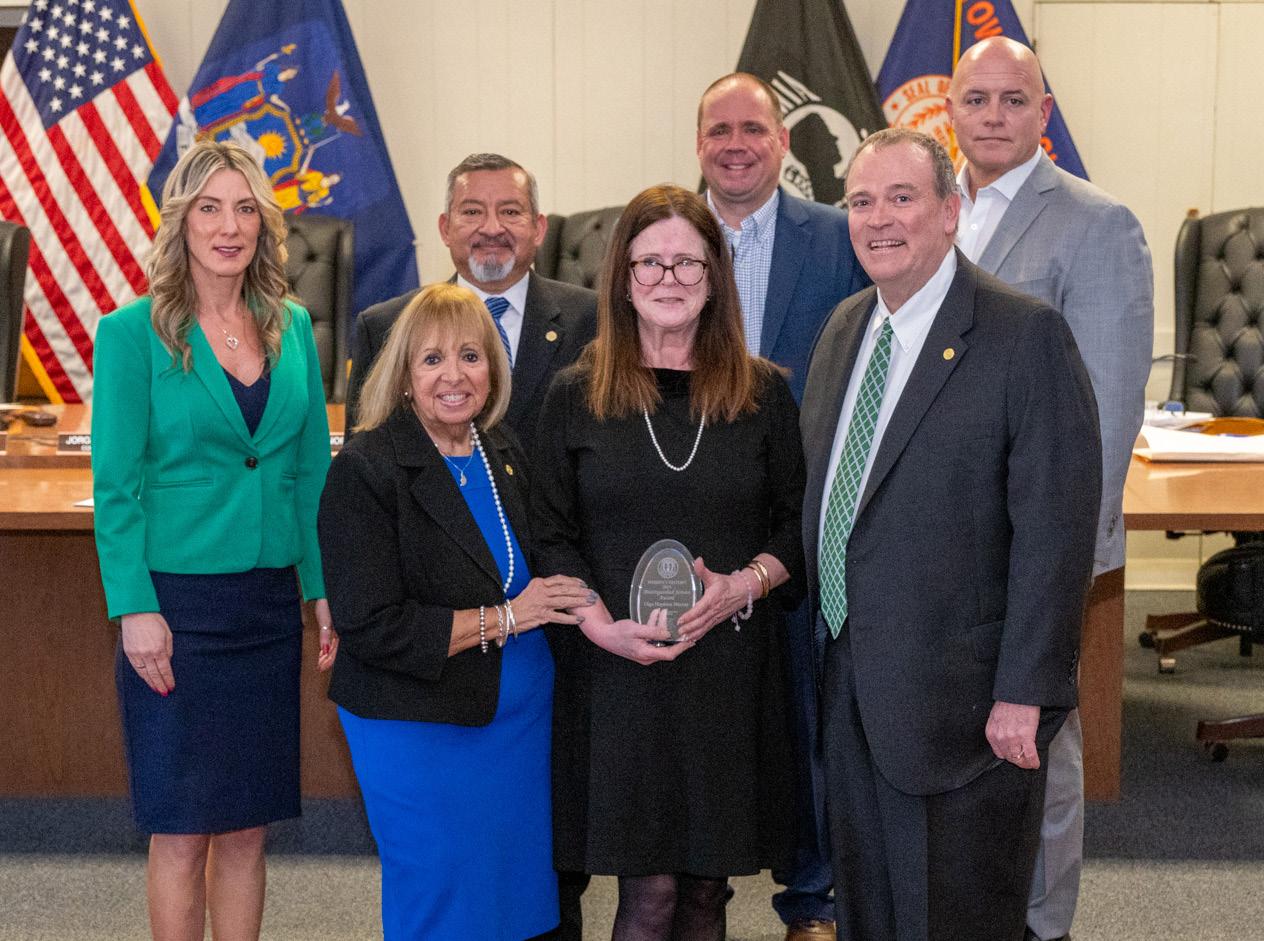
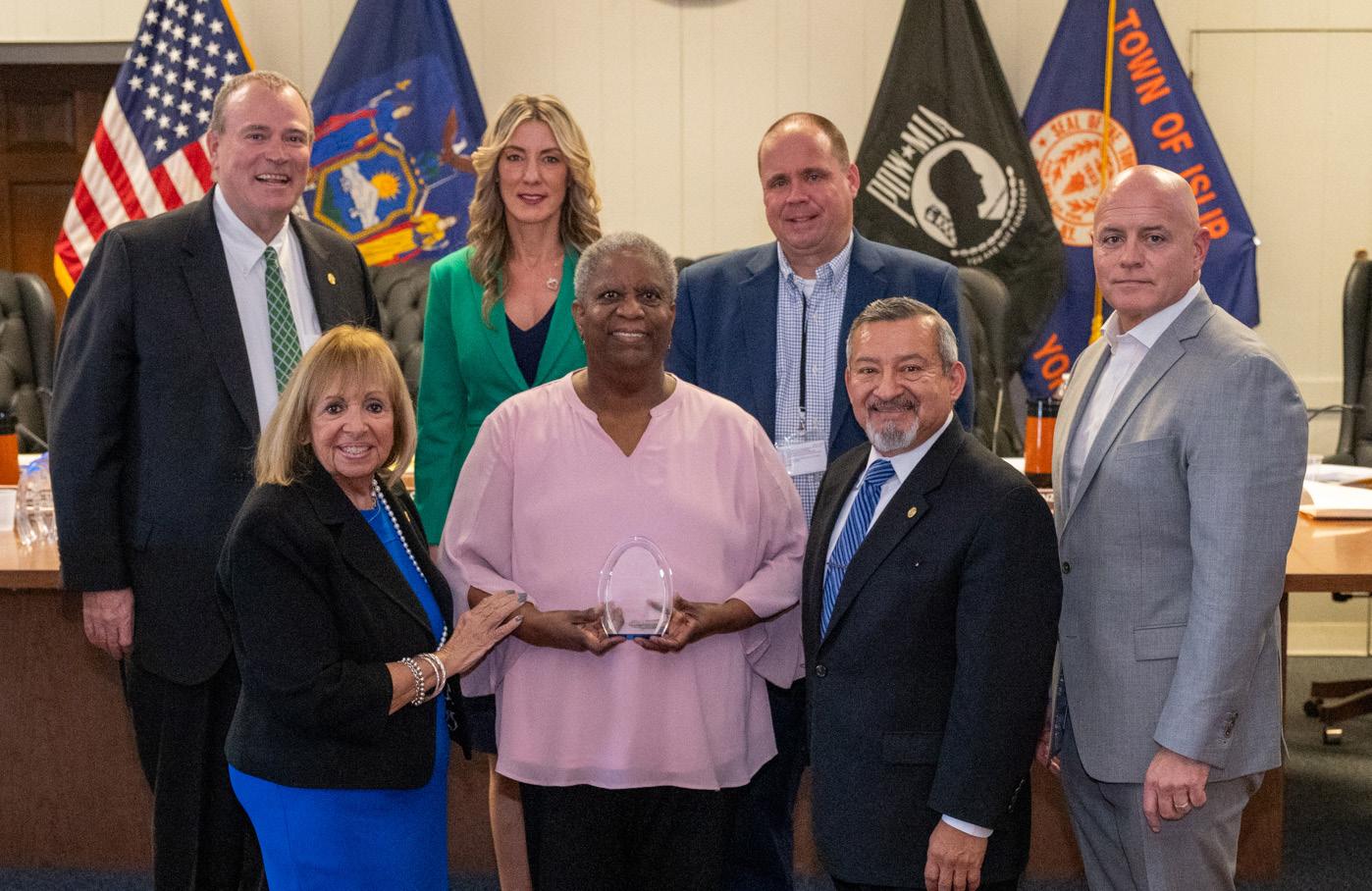



Published by Messenger Papers, Inc.
By Ellyn Okvist, B.Sc.
Thursday, March 20, 2025
Lillian Brown Devere, Mary Davis, Susanna Sjöstrand Okvist Sullivan, Maude Ewing Adams Kiskadden, Louise Rummel, Ava Overton, Frances Vogel Falkman, Louise Lauderville Winsche, Dorothy Phinney, Harriet May Mills, Nan Melton McGarity, Evangeline Slattery-Smith, The Finley Sisters, the Seibert Family, the Hallock Sisters, the Hawkins Sisters, the Farnum Sisters, Rosemary Cleary, May Miller Duffield, the Badman Family, and Helen Seibert Halik Carter.
The members spread from 1912 to well into the 1950s. Equality for women has been a battle, first lasting 100 years and in many ways still goes on today.
Do we have every Lake Ronkonkoma participant’s name? No, but we continue our research to find them. The names we do have are highly recognizable.
The perseverance and belief in their cause is what will continue to remind the world of the fight we so bravely faced. During World War I, the suffrage cause was stopped until the war was over with full respect to our soldiers fighting. The work that was accomplished here on Long Island was unmatched. Food was collected and sent to the war effort. This project may be amongst the largest ever carried out in our country.
At first, the meetings of the Lake Ronkonkoma Equal Rights Suffrage Club were held at the homes of the members. The Seibert home was popular, and finally an agreement to hold the meetings at the official “clubhouse”, Fisk’s Confectionary. The homes of secretary, Miss May Miller and Mrs. John Overton were also used. Additional meetings were held at the Devere home or the Lake Ronkonkoma Free Library and were scheduled when Rosalie Gardiner Jones visited for planning and education, bringing Miss Harriet May Mills and guest speaker Miss Cora E. Morlan. Miss Jane Olcott brought magic lantern slides on March 20, 1913. Miss Olcott won the men over to the suffrage cause and they all wanted her to come again.


Lillian Devere spoke of the first year of the club as active, giving dances, euchre, and having booths at the Athletic Meets on Declaration Day, Fourth of July and Labor Day, selling about eighteen dollars’ worth of suffrage flags and novelties. At the two-day Carnival held on the Fourth and fifth of July, the Club joined in the Parade with Miss Rosalie Gardiner Jones hiking along and an automobile decorated with Suffrage flags, with Mrs. Edna Kearns and Miss Welch of New York riding on it. Miss Jones spoke three or four times during the two days. Mrs. Kearns and Miss Welch each took their turn. Mrs. Kearns also gave the “voiceless speech” in Long Beach, Nassau County.
The Lake Ronkonkoma Free Library, now Sachem Public Library, had its roots in the Women’s Suffrage Movement. The Club had the Traveling Library for four months. It was housed in the home of Mrs. Devere. It was loaned from the Equal Franchise Society and The Club was complimented by the Society’s Librarian on its circulation.
The early librarians of the Lake Ronkonkoma Free Library were all members of Suffrage Club. Ada Overton, Eva Slattery-Smith, Nan McGarity, Helen Halik all did what they could. In 1929, the civic-minded housewife Nan McGarity raised enough money to refurbish the interior of the Lake Ronkonkoma Free Library. This she accomplished in an original manner: her one-woman campaign ensued with the hint from George Raynor. Nan stood at the junction of Ronkonkoma Avenue and Church Streets waving a large white handkerchief to passing cars. As each one stopped, she asked for a contribution. In one day, $250 was raised in this manner. At today’s standards, this would total $5,740.90. Needless to say, the board was astonished as well as grateful for the effectiveness of

her endeavors. She was married to Jay McGarity, and mother of John.

“Signatures were gotten for the Petition for the amendment to the Constitution and all letters from Congressional Union were acted upon. As often as possible Suffrage notices were put in the Brooklyn Daily Times”. Per Mrs. Devere- “We sold Votes for Women ‘Ryte-Me’ [Postcard] Calendars”, and on February 25 we sold Suffrage Editions of the New York Evening Sun.”
Parades were a main way to show the public the strength of the women fighting for Suffrage in the United States. Lake Ronkonkoma held parades, such as the July 4-5 as mentioned, but the greatest honor was the participation in the larger city parades. Delegations from Lake Ronkonkoma joined in the New York Parade in November 1912 and in the Brooklyn Parade in November 1913. The Lake Ronkonkoma Equal Rights Suffrage Club had the honor of carrying the New York State Flag.
Lake Ronkonkoma has celebrated our Suffrage history many times. The NYS Historical Marker was installed by the LR Heritage Association on May 13, 2017, at the American Legion Post #155, a fitting place to honor Lillian Devere. Representatives from local politics were present, as the picture reveals. A Parade and Rally was held on September 10, 2017, by the LR Heritage and Brookhaven Town Clerk Donna Lent (I-Blue Point).
Over 700 people marched with us from the Lake Ronkonkoma Free Library to the American Legion Post #155, where speeches, refreshments, and education were enjoyed. Island-wide attendance was noted. The one hundredth anniversary of the Lake Ronkonkoma Free Library was celebrated with the Sachem Public Library on April 17, 2016, with a parade down Hawkins Avenue and refreshments with education at the Lake Ronkonkoma Fire Commissioners Building. We have held many other events, all fun and historic. Our favorite photo from the Parade and Luncheon held on March 1, 2015 (pictured left), shows Nancy Mion (AAUW of Islip) and Steve Lantz, our VP, making the march to Lillian Devere’s home (which was demolished by its current owners) and then back to Flanagan’s for lunch, where, as usual, they went all-out for our group.
The following is a small collection of some of the newspaper articles that credit the Lake Ronkonkoma Club:
Saturday November 9, 1912, The Brooklyn Daily Times reports “Equal Suffrage Club Meets: Lake Ronkonkoma, L.I., Nov. 9—The Equal Rights Suffrage Club of Lake Ronkonkoma met a few evenings ago at Mr. Fisk’s. They have engaged the ice cream parlor for the season as a club room. This evening, six of the members will join in the torchlight parade which starts at Fifty-Eighth Street and Fifth Avenue, Manhattan.”
This day was a well-earned award, as the Club led the HUGE Suffrage Parade in Manhattan that day. The members of the Club were honored for their establishing the Club and the fine work they were accomplishing.
On July 4, 1913, Rosalie Gardiner Jones walked a parade followed by local suffragists including Lillian Devere, where Miss Jones made a speech before and after the Parade in front of the Indian Hill Hotel, standing next to the suffrage car.
Saturday, February 1, 1913, The Brooklyn Daily Times reports, “The Equal Suffrage Club, of this place (Lake Ronkonkoma) is jubilant over the great victory of the Suffrage Bill passing both the Senate and the Assembly. Both the American flag and the New York State pennant were displayed in celebration of the event.”
Saturday, December 6, 1913, The Brooklyn Daily Times reports, “The Equal Suffrage Club is awaiting the result of this week’s work of the National American Woman Suffrage Association in Washington, D.C., with Dr. Anna Howard Shaw presiding. President Wilson is to be called on to adopt the woman suffrage constitutional amendment as an administrative measure, and the Senate to act favorably upon it; also request for an appointment of a house committee. The local club will celebrate if the convention is successful.”
Saturday, January 24, 1914, The Brooklyn Daily Times reports, “Mrs. D.F. Seibert held a jubilee at her home Monday evening, for suffrage; her only regret was that her suffrage club was unable to attend.”
Wednesday, April 7, 1915, The Brooklyn Daily Times reports, “Women taxpayers at Lake Ronkonkoma went to the polls and voted on appropriations yesterday. The suffrage car went out decorated with flags, but the roads were in such bad condition not so many women could be reached as might have been on a fine day. The captain of this election district secured many enrollments, all the representative men of the place signing in favor of suffrage in 1915.
Tuesday, May 4, 1915, The Brooklyn Daily Times reports, “LAKE RONKONKOMA LIVELY” Mrs. Lillian Devere, president of Ronkonkoma Club, reports that suffragists are arranging a euchre for their share of earnings towards suffrage.
Wednesday, June 25, 1915, The Brooklyn Daily Times reports, “RONKONKOMA EUCHRE. The suffragists of Lake Ronkonkoma, under the able supervision of Mrs. Lillian Devere, are getting up a progressive euchre for suffrage on June 25
Saturday, October 23, 1915, The Brooklyn Daily Times reports, “the Suffrage canvassing is going on merrily.”
Saturday, March 24, 1917, The Brooklyn Daily Times reports, “The Lake Ronkonkoma Equal Rights Suffrage Club met at the home of the secretary, Miss May Miller, recently. The next meeting will be held at Mrs. John Overton’s Friday, April 20.”
The Suffrage movement was fought for one thing – the right to vote. During the one hundred years it took, many other avenues of government, business, literature, science, and the like became available to women of the United States. Lake Ronkonkoma had its women, solid and determined to vote and have a say for all women. We are proud of all of you. Thank you.
Published
by Messenger Papers, Inc. Thursday, March 20, 2025
By Mollie Barnett
The business landscape stands at a pivotal inflection point in Artificial Intelligence (AI) adoption. Recent Pew Research Center findings-analyzed by AP and The Economist-reveal a significant disconnect between AI’s transformative potential and its actual implementation across American businesses [Pew Research Center, AI Adoption in U.S. Businesses, 2024].
This gap isn’t primarily technological but human: a complex blend of perception, organizational structure, and the persistent challenge of adapting to profound change. Organizations that successfully navigate this transition aren’t merely implementing new tools - they’re fundamentally reimagining how work happens. The most forwardthinking leaders recognize that AI adoption requires breaking down longestablished silos and creating new collaborative frameworks that enable innovation to flourish [McKinsey, The AI Imperative, 2024].
The path forward requires recognizing that AI adoption is fundamentally about organizational adaptation rather than merely technological implementation. Successful integration demands reimagining not just technology stacks but organizational structures, decision processes, and operational workflows.
“Our entire corporate systems are set up to act linearly, our process management is linear, our education, rewards and promotional corporate systems are linear-AI is not linear. It is patterned and synergistic,” observes one AI educator. This structural mismatch explains why many businesses struggle with AI integration despite understanding its importance. The question isn’t whether businesses will adopt AI, but how gracefully they’ll navigate the transition. Breaking open the black box requires less technical expertise than organizational courage - the willingness to evolve not just tools but thinking.
• Education and demystification that focuses on practical applications rather than technical complexity
• Transparency and explainability in AI systems to build user trust
• Ethical frameworks addressing privacy, bias and security concerns
• Human-centered design emphasizing AI as augmentation rather than replacement
• Collaborative implementation that involves employees in the discovery process.
Looking for value integration and discovering AI implementation uses themselves, the efforts become collaborative. Making the entire team part of the process helps break down the walls to adaptation.
“No one doubts that technology is advancing at warp speed. And no one person alone can keep up with every new development, which is why cross functional collaboration is the key to effective AI integration,” says Kiki Orski of Peak Performance Consulting. “Teams need to break down silos so data and information can flow freely and everyone can collaborate. When everyone’s on the same page, AI can do what it’s meant to do-drive real impact.”
An incremental approach that begins with small, targeted implementations demonstrating clear value before expanding builds confidence while developing institutional AI literacy. This strategy provides tangible wins that help overcome resistance while gradually building organizational capability.
Understanding the “Black Box” Barrier
The truth is this represents new territory for all of us. AI is surprising even top experts in the field. Once AI enters a phase of self-learning-where it learns from its own outputs and interactions, it can surprise the most seasoned analysts. This sentiment echoes across boardrooms and team meetings, where decision-makers struggle with implementing technology they can’t truly comprehend and that doesn’t fit into any preconceived category.
The resistance runs deeper than technical understanding. AI represents not merely a new tool but an entirely new paradigm. Unlike the addition of the Internet, it more closely resembles the transition from horsedrawn carriages to automobiles. That shift didn’t simply replace horses with engines; it necessitated new infrastructure, regulations, licensing systems, and cultural adaptations.
The velocity of AI advancement has created what Ruben Hassid, AI Engineer and Founder of Easy Gen, describes as an unprecedented situation: “You can’t keep up with AI. No one can. No one will... AI moves so fast you can’t feel it... It’s better to move forward (and turn occasionally) than standing there watching the world spinning”.
This relentless pace contributes to decision paralysis, where businessesparticularly smaller enterprises-find themselves frozen in place, unsure how to begin their AI journey amid constantly shifting technological terrain.

Organizations that successfully integrate AI typically employ systematic approaches that address both technological and human elements [McKinsey, AI Adoption Strategies, 2024]:

What exactly is the “Black Box Problem” hindering AI adoption? It describes the opacity surrounding how advanced AI systems function-a complexity that breeds uncertainty even among technical experts [MIT Technology Review, The Black Box Challenge, 2024].
The challenge is critical: those that adopt, and adopt correctly, are reaching an inflection point where incremental growth is becoming exponential, where AI becomes agentic, and nonadopters will simply miss the turn into the next era of industry.
The Perception vs. Reality Gap
A critical misconception surrounds AI’s accessibility and cost. While many perceive implementation as cost-prohibitive and complex, the reality is that it is not much more expensive than developing a website, with numerous options available:
• Cloud-based AI solutions offer scalable, pay-as-you-go models
• No-code/low-code platforms enable non-technical users to leverage AI
• Open-source tools provide costeffective entry points
• AI-as-a-Service offerings deliver specialized capabilities without infrastructure investment
• Existing software increasingly incorporates AI functionality by default
The actual barriers prove more psychological than practical: fear of the unknown, risk aversion, and the “if it ain’t broke, don’t fix it” mentality.
The “In the Box” Incumbent: Software-as-a-Service (SaaS) Limitations
Organizations taking a cautious approach often explore AI through existing software providers, with limited functionality and strong safety guardrails. These “AI in a Box” prepackaged solutions, while convenient, create:
• Limited functionality confined to vendor-defined capabilities
• Data silos preventing comprehensive AI implementation
• Restricted customization opportunities
• Barriers to true strategic AI integration
In-the-box solutions create an illusion of AI adoption without delivering its transformative potential and may lead to unauthorized AI use-known as Shadow AI, which could jeopardize organizational security, and eventually leave you behind the revolution.
Despite resistance, market forces make AI adoption increasingly unavoidable. Businesses face a stark choice: proactively shape their AI future or reactively adapt to externally imposed change.
The competitive landscape has reached a frenetic pace, with AIenabled organizations gaining significant advantages in efficiency, customer experience, and innovation capacity. Those failing to adapt risk not just competitive disadvantages but potential obsolescence. As with previous technological revolutions, some organizations will embrace change and thrive, others will cautiously adapt, and some will resist until market forces leave no alternative.
The difference today lies in the unprecedented speed of this evolutionmaking the cost of hesitation potentially much higher.



Published by Messenger Papers, Inc.
Thursday, March 20, 2025
By Robert B. Charles |AMAC
In another extraordinary ruling by an Obama-appointed judge on March 15th, US District Judge James Boasberg tried to stop President Trump from exercising Article II authority under the “Alien Enemies Act of 1798,” companion to the 1798 “Alien Friends Act.” Like John Adams, Trump was legally right, but the Obama judge – smart as he is –was legally wrong.
Fact: A dangerous Venezuelan group, called “Tren de Aragua,” penetrated the southern border – illegally – under President Joe Biden, setting up headquarters in Chicago.
Fact: Tren de Aragua quickly spread – as far north as New England. The 5000-strong group is not political but is ruthless, trafficking in drugs, guns, women, and terror. They operate in 12 countries and are designated as a Foreign Terrorist Organization (FTO).
Fact: The text of the “Alien Enemies Act” is not ambiguous. While infrequently used, by Adams in 1798 against illegal aliens (US not at war), by Democrat Woodrow Wilson in WWI, and by Democrat FDR in WWII, the text is clear.
Fact: The Act is not about sedition, but security threatened by “alien enemies.” It is triggered by war, that is true. It is ALSO triggered – allowing a president to act under its authority – when “any invasion or predatory incursion shall be perpetrated, attempted, or threatened against the territory of the United States…”
Fact: While the act discusses war with a foreign nation or government, definitions are missing. Needed would be Venezuelan approval of (or acquiescence in) the group’s actions. The group operated with impunity, until recently, in Venezuela. They had a headquarters not taken down. They killed opponents of Venezuelan leader, Maduro.
Fact: Donald Trump discussed repeatedly his intent to exercise Article II and statutory powers under this act. He might as easily have exercised powers under its companion act, the “Alien Friends Act,” which requires no finding of hostility, only illegality.
Fact: President Trump began arresting members of the group in January 2025, as promised. He initiated orders for a flight to Venezuela in early March and negotiated an agreement with the Venezuelan government to receive 300 members of the group.
Fact: To assist in supporting the rule of law in Venezuela and imprisonment of these group members – for US citizens and Venezuelan benefit – he provided six million dollars to the Venezuelan government. The government received and imprisoned the gang on March 15.
Fact: After two planeloads of violent criminals were aloft, outside US airspace, over international waters, the Obama judge threw a fit. More precisely, he ordered the plane to return with these 300 members of the violent, invading Venezuelan gang.
Fact: The Obama judge, who previously ruled for whales over lobstermen, demanded of the President: “Any plane containing these folks that are going to take off or is in the air needs to be returned to the United States,
however, that is accomplished. Make sure it’s complied with immediately.”
Fact: Judges, of course, are important. Respect for them is important. They have authorities granted by Congress, except the Supreme Court, tied to the Constitution.
Opinion: This judge was way out over his skis. Frantically, and ideologically, he was trying to stop a president from exercising authorities granted to him by Article II and statute. Trump by law conducts foreign affairs and protects, not an Obama judge.
Opinion: More irritating, that one judge cannot decide for America when to turn an aircraft carrier, satellite, or plane full of terrorists around, and bring them back.
Overview - AMAC -
The Association of Mature American Citizens
The Association of Mature American Citizens represents Americans 50 plus. AMAC is centered on American values, freedom of the individual, free speech, and exercise of religion, equality of opportunity, sanctity of life, rule of law, and love of family, with benefits at all levels.
AMAC plays a vital role in helping build the services that will enrich the lives of America’s seniors. AMAC Action, a 501 (C)(4) advocates for issues important to AMAC’s membership on Capitol Hill and locally through grassroots activism. To Learn more, visit amac.us
Bottom line: Democrat-appointed judges, like their cohorts in Congress, governorships, and state legislatures, are lost. Trump was legally right, assessment sound. Members of an FTO are “alien enemies,” deportable., Trump wins, Obama judge loses. End of story.
Robert Charles is a former Assistant Secretary of State under Colin Powell, former Reagan and Bush 41 White House staffer, attorney, and naval intelligence officer (USNR). He wrote “Narcotics and Terrorism” (2003), “Eagles and Evergreens” (2018), and is National Spokesman for AMAC. Robert Charles has also just released an uplifting new book, “Cherish America: Stories of Courage, Character, and Kindness” (Tower Publishing, 2024).








Etymology: from Latin ‘parsimonia’, meaning “frugality, sparingess”; from the Latin verb ‘pacere’, meaning “to spare”.
Earliest known use of the word found in 1591 writings of Henry Barrow, a religious separatist.
adjective
Pronounced: /paar·suh·mow·nee·uhs/
Definition: unwilling to spend money or use resources; stingy or frugal.
Example: “His parsimonious behavior was seen as his only truly negative quality.”
Synonyms: miserly, illiberal, close-fisted
Antonyms: generous, extravagant, lavish
Source: Oxford Languages


E S A P H I N
See how many words you can create. Must have center letter in word and can use letters more than once. 4 letter word minimum.


See bottom left for the answers (please don’t cheat!)

March 26, 1953: Dr. Jonas Salk announces that he has successfully tested a vaccine to prevent polio, clinical trials began the next year.


March 25, 1939: Billboard Magazine introduces hillbilly (country) music chart.
March 24, 1882: German scientist Robert Koch discovers and describes the tubercle bacillus which causes tuberculosis (Mycobacterium tuberculosis), and establishes germ theory.

March 20, 1854: Republican Party formally organized in Ripon, Wisconsin.

March 23, 1743: George Frideric Handel’s oratorio “Messiah” premieres at the Royal Opera House, Covent Garden, London.
March 21, 2024: Elon Musk’s Neuralink company posts a video of a patient playing chess online through their brain implant.
March 22, 1622: First American Indian (Powhatan) massacre of Europeans around Jamestown, Virginia, 347 killed.

By PJ Balzer
Whether you like, dislike, or are indifferent to Rick Pitino, he’s back in New York and here to stay.
The current coach of the men’s basketball team at St. John’s University has etched himself, once again, into the history books in the basketball world - this time, right in our own backyard.
Coach Pitino was born on September 18, 1952. He’s a native of New York City, growing up in the Midtown area right around Madison Square Garden. He speaks often of traveling out to the parks in Queens, specifically in Cambria Heights, to find good pick-up games and other tough defenders to challenge his ball handling abilities.
For high school, Pitino commuted out to Long Island where he was a standout guard for St. Dominic High School in Oyster Bay from 1966 to 1970. He went on to play college basketball at the University of Massachusetts-Amherst, where he was also a point guard that saw and knew the court extremely well. Pitino is known for having a basketball IQ that’s second-to-none.
After receiving his degree at the University of Massachusetts Amherst, Pitino’s first coaching job was as a graduate assistant coach at the University of Hawaii. He then served as an assistant coach at Syracuse University in upstate New York for two seasons, from 1976 to 1978. His very first position as a head coach was at Boston University from 1978 to 1983. Rick Pitino was only twenty-five years old at the time, not much older than the players he was coaching.

Since then, Pitino has coached at six different schools, most of them basketball powerhouses with a long legacy of success. Schools including Providence, Kentucky, Louisville, Iona, and now St. John’s University. With his current success this season at St. John’s, Pitino has now led each of these schools into qualifying for the NCAA tournament. He’s been in the NCAA Tournament final four championship games six different times. While leading two of those teams to hold up the NCAA championship trophy (1996 Kentucky, 2013 Louisville). Coach Pitino is no stranger to winning and even having the opportunity to cut down those nets after the championship game that every college coach and player dreams about.
Pitino is known well to be a no-nonsense guy and coach. He’s known to be tough on his players and a giver of tough love. He’s a professional at establishing the Alpha amongst his team, letting everyone in the gym know that he’s the bull in charge. Coach Pitino has been handed the nickname as one of the “godfathers” of college basketball and possibly even the game as a whole. He’s a man of only a few words but also won’t hesitate to give his players their praise when he feels the job on the court was well done. Pitino is also known to love a good Sunday sauce simmered by his wife, along with his favorite dish spaghetti carbonara.
To create this current perfect storm that New York hoops fans are witnessing is a feat in and of itself. Up until last year, St. John’s had a somewhat dormant college basketball program that sat in ashes of its once high glory. With a rich program history that involved Chris Mullen, Mark Jackson, Malik Sealy Lopez, the late legendary coach Lou Carnesecca, who led St. John’s to a national championship in the late 1990s, “The Johnnie’s” used to have a faithful fan base that would pack out Madison Square Garden to watch the city’s favorite college team compete in the Big East. It’s from this fallen state that St. John’s tapped Rick Pitino into the ring.
To attempt a redemption of the program last year, St. John’s brought in a seasoned, “Grandmaster” of the game of basketball. He knows the game inside and out, its many strategies, and components. He’s seen a lot on and off the court; Coach Pitino has won well and lost well. He understands the game from
many angles, including the mental component, the work component and even the recruiting component. He knows what it takes to build a winning basketball team that competes every minute of every game. Even his current player recruiting strategy of drawing solely from the transfer portal is unconventional but has proven to be successful.
The proof is in the pudding.
On Utopia Parkway in Queens, it feels like a brand-new leaf has been turned over. Pitino came in last year and turned the place upside-down and right-side-up again. St. John’s hadn’t been the Big East champs since 2000, the longest drought of a Big East title in school history. They also haven’t been ranked among the top ten teams in the nation (according to the AP poll) since the 1989 season.

Last week, the Red Storm, who is currently 304, held up the Big East trophy before a packedout sea of red and white shirts in Madison Square Garden - just like the good ole’ days. They are currently ranked number-six in the entire nation. Their Big East title earned them an automatic bid into the big dance beginning this week, the NCAA tournament. They have been given the two-seed in the western bracket and will be facing a tough Omaha team this Thursday, March 20, at 9:45p.m.
It’s been a historic season for the Pitino family as a whole as Rick Pitino was named Big East coach of the year. While his son Richard Pitino, who coaches across the map in New Mexico, was also named coach of the year in his conference. They have become the first ever father-son duo to do so in the same year.
St. John’s is New York’s team once again after more than two decades of mediocrity and irrelevancy. But it’s not only talent that has risen the program back to life. It’s been what basketball fans know as “The Pitino Effect.” He is ultimately successful wherever he goes and has winning running through his veins.
“Great win for the city,” St. John’s coach Rick Pitino said. “Great win for our university. You hear it all along that it’s New York’s team, and it truly is. As a New Yorker myself, I’m very proud that St. John’s has gotten to this level. We’re all excited. We’re all thrilled.”
Let’s go Johnnie’s!
By Ashley Pavlakis
Girls’ basketball wrapped up earlier this month with the Suffolk County Championship taking place on March 9. The Brentwood girls’ varsity basketball team had a dominant season en route to the championship win.
The Brentwood Spartans girls’ basketball team is a member of the New York State Public High School Athletic Association (NYSPHSAA) and competes in League I. The girls are led by sixteenth-year head coach Keith Greene who is joined courtside by assistant coaches Malik Jackson, Shannon McGuire, and Chanel Taylor.
“Our mantra this year was ‘enjoy the journey’, so we were really trying to stay dialed into one game at a time and never really looking ahead,” said Greene
The Spartans capped off their first undefeated league season in program history with an 18-2 record. The only two losses came against non-conference teams in Elmont and Hauppauge. This phenomenal run earned them the title of League I champions. Aside from that, the team was consistent on the court, putting up 50-plus-point efforts more often than not.
“League I is always a grueling schedule, and I thought that we really responded well, especially early on in the season. We had two tough road tests going out to Riverhead and William Floyd, they’ve been tough games in the last couple of years. Just watching our response, especially in our first league game against Riverhead. With our defensive effort, we were definitely truly happy. Anytime you can defeat the defending league champions, county champions, and Long Island champions in Walt Whitman, I think that kind of set us up to really get rolling, the girls just responded all the way,” said Greene.
The Section XI Class AAA playoffs took the Spartans on a run, with stops at Huntington and Ward Melville before meeting Walt Whitman in the title matchup. During the regular season, the Spartans took on the WW twice, having emerged victorious each time. The matchup was on the low-scoring end, but it proved to be enough as the Spartans claimed the championship, winning 41-32.
“Obviously when we defeated [Walt] Whitman a second time at their place, it was the defensive effort we put together, going on the road and playing in a tough environment, responding to adversity throughout that game and coming out on top, I think we thought it was a possibility. When you’re looking at the other leagues, there were still some teams we hadn’t seen or played so we didn’t want to get ahead of ourselves. I think that has always been one of our Achilles heels, can we beat those perennial powerhouses, not only once in a season but try to defeat them twice. Once we defeated them a second time, we reality felt good about ourselves,” said Greene about his team possibly going all the way.
Legislator Steven J. Flotteron (R-Brightwaters) recognized Frederick E. Herrmann for his 50 years of active service to his community and the Islip Fire Department.
After joining the department on March 17, 1975, firefighter Herrmann entered the ranks of the Hook and Ladder Company and quickly excelled in his craft. He was elected Second Lieutenant in 1980 serving through 1982, First Lieutenant in 1982 serving through 1984, and Company Captain in 1984 and serving through 1986.
After twenty-two years, he transferred to Engine Company #1, assuming a leadership role with several other members in the department by organizing a specialized tactical rescue unit. This unit became responsible for such rescue disciplines as: High/ Low angle rope rescues; underwater search and rescue; ice emergencies; confined space; vehicle extrication; and hazardous materials incidents. He was later elected as the Tactical Rescue Company’s inaugural Captain in 1998 serving through 2000.
Throughout his career, he has been instrumental in the training and educating of members in the department, serving as one of the department’s first designated training officers. After sixteen years, he transferred to the Fire Police Company, where he remains an active member.
Given this remarkable achievement, the department is proud to bestow him with the rank of Honorary Chief.
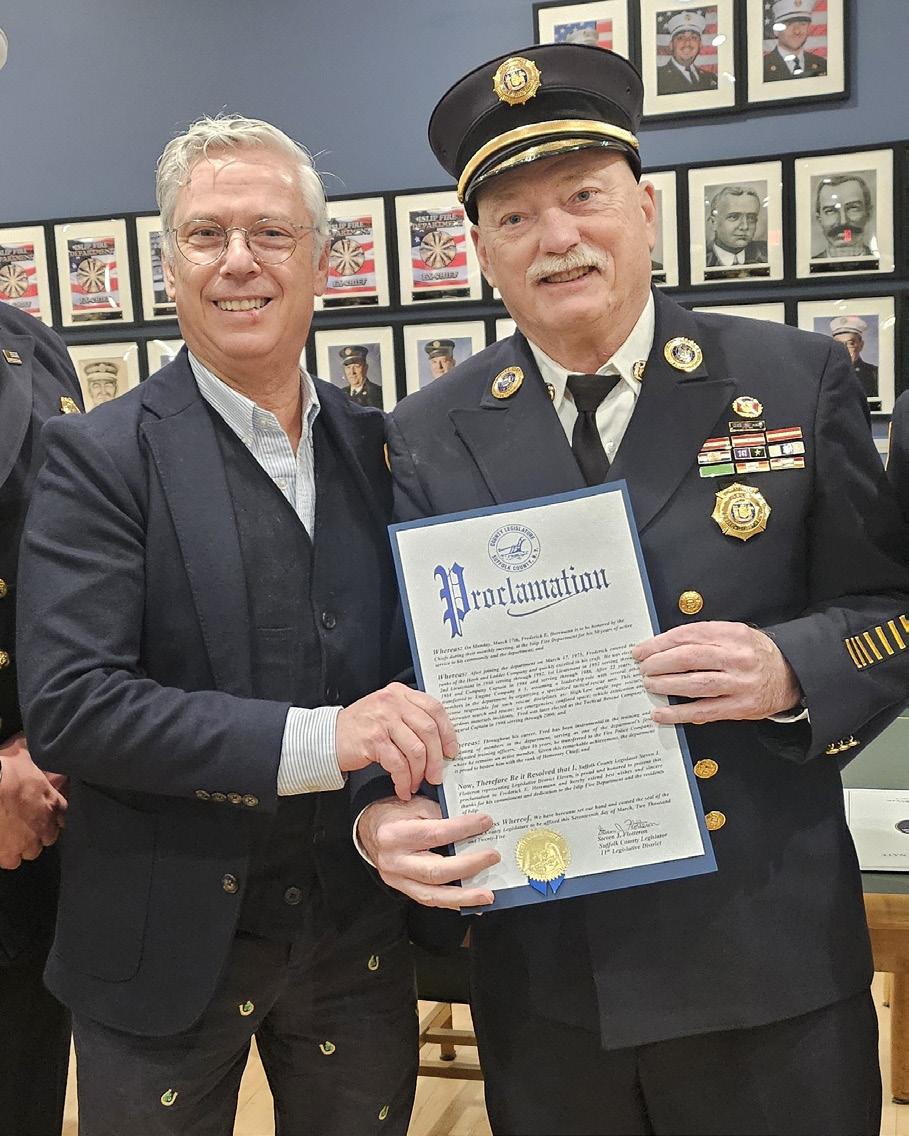
Greene stressed the importance of being a solid unit on and off the court as the factor of their success.
“I’d say the commitment to the offseason [is important]. During the summer many of them made sure that they continued to play AAU. When we got back in the fall we were lifting three days a week, practice two days a week, and a fall league game. It was a lot of basketball, but it was definitely the commitment and camaraderie that was the greatest difference,” said Greene.
A Suffolk County Championship banner will hang on the wall, showcasing their title as Class AAA champions. For Greene, he’s most happy about the process it took to get there.
“I think anytime you win it’s exciting, but I think the way that we won it, I think that’s the thing that brings the most joy to my heart. We didn’t skip any steps in the process. Being able to build it from the beginning with the entire group, and everyone was there though each stage of it, I think that’s what makes it most rewarding. I think we were going to be ok with whatever happened whether we won a league or Suffolk title, we put the time and effort into really building each other up. It’s definitely an exhilarating feeling, but the joy comes from the group of young people that we were able to do it with,” Greene told The Messenger


By Raheem Soto
A Suffolk County father has admitted his role in one of the most heartbreaking cases to hit Long Island in recent memory — the overdose death of his fourteen-month-old son, Joseph Adonis (right). Wilkens Adonis (inset), 39, of Holbrook, pleaded guilty to manslaughter in the second degree this week, taking responsibility for exposing his toddler to a dangerous combination of fentanyl, heroin, and cocaine.
It all started on January 3, 2024, when Suffolk County Police responded to a 911 call at a quiet Holbrook residence. Inside the house, officers found baby Joseph unresponsive in the bedroom he shared with his father and his father’s girlfriend. First responders rushed the child to Stony Brook University Hospital, but the little boy was pronounced dead shortly after arrival.
What investigators found next was devastating. The Suffolk County Homicide Squad and Narcotics Section uncovered a disturbing scene. Not only were illegal drugs present in the room where the toddler had been found, but the amount and variety were shocking: over one-eighth of an ounce of heroin and fentanyl, another eighth-ounce of cocaine, plus methadone, alprazolam, drug packaging supplies, digital scales, and loaded firearms — including a shotgun and a rifle — all within reach of children living in the home.
The autopsy performed by the Suffolk County Medical Examiner’s Office confirmed what officers had feared: Joseph’s cause of death was acute mixed drug intoxication from heroin, cocaine, and fentanyl.
District Attorney Ray Tierney (R) called the case “one of the most


heartbreaking cases our office has ever handled” and pointed out that it was only due to “extreme recklessness” that prosecutors could even bring manslaughter charges. In most cases like this, Tierney noted, New York law doesn’t allow for manslaughter or murder charges, and he renewed his call for the state legislature to pass Chelsey’s Law — a measure aimed at strengthening prosecution in drugrelated child death cases.
Following a thorough investigation, Adonis entered his guilty plea on March 17, 2024, before Acting Supreme Court Justice Philip Goglas. He pleaded guilty not just to manslaughter but also to criminal possession of a controlled substance in the fourth degree and endangering the welfare of a child, a misdemeanor.
Adonis now faces a prison sentence of five to fifteen years and is scheduled to return to court for sentencing on April 17, 2025. He is represented by attorney Matthew Tuohy, Esq.
This tragic case was investigated by Suffolk County Police Detectives James Melchiona and Christopher Gleason from the Narcotics Section, along with Detectives Guido Cirenza and Michael Repperger from the Homicide Squad. Investigator Scott Reilly and Senior Investigator David Ferreby of the New York State Police also assisted. The prosecution is being handled by Assistant District Attorney Robert Archer of the Narcotics Bureau.
While the legal proceedings continue, the devastating loss of baby Joseph remains a painful reminder of the dangers children face when surrounded by drugs and weapons — and the high cost of carelessness no family can afford.


By Cindi Sansone-Braff


A must-see theatrical event, the Twenty-Sixth Annual Festival of One-Act Plays, runs through April 5, 2025, at Theatre Three’s iconic The Ronald F. Peierls Theatre on the Second Stage. Seven short plays, selected from more than 1,000 submissions, received world premieres. These fullystaged productions are directed by Jeffrey Sanzel, an artistic visionary who brings the playwrights’ words and characters to life while creating a thoroughly entertaining experience for the audience. The top-notch ensemble includes Julia Albino, Steve Ayle, Will Brennan, Samantha Fierro, Jason Furnari, Jae Hughes, Brittany Lacey, Phyllis March, Linda May, Douglas Quattrock, Evan Teich, and Steven Uihlein.
The first act consists of four well-crafted plays that explore interpersonal dynamics and dysfunction, including the slippery slope inherent in parent-child relationships, the drama and trauma couples face, and the soul family we surround ourselves with to survive in an increasingly apocalyptic world.
The festival opened with “A Happy Child” by Melinda Gros. This heartrending drama explores the emotional tightrope a mother treads with her dysfunctional adult child. Hughes gave a riveting performance as Rory, a lost soul adrift in a sea of inner turmoil. May was believable as a devoted mother anxious to rekindle a relationship with her distant child. The play ends on a hopeful note with the spotting of a hawk.
The next play featured a dark comedy by D.L. Siegel, “Monster Love,” reminiscent of “The Munsters” or “The Addams Family.” Ayle rocked the role of Victor, the jovial, charismatic mad scientist hellbent on making his daughter’s upcoming wedding day memorable. Albino delivered an outstanding performance as his kindhearted daughter. However, Victor’s otherworldly creation, brilliantly portrayed by Fierro, stole the show!
Melanie Acampora’s one-acts have been in two previous Theatre Three Festivals, “When Driven” in 2016 and “Bird Feed” in 2017. Her latest effort, “Too Much Fondant,” offers a highly relatable but painful-to-watch unraveling of a couple’s long-term relationship. Teich as the emotionally detached, work-driven Ryan and Lacey as his disgruntled partner displayed electrifying onstage chemistry.
The first half of the festival closed with a dark drama, “Final Dress, or Places for the End of the World,” by Mathew Green. In a world on the brink of extinction, a local community theatre rehearses “Romeo and Juliet” because we all know “the play’s the thing,” and the show must go on.


including Furnari as Larry, Hughes as Jess, Brennan as Luke, Fierro as Amy, March as Bobbi, and Uihlein as Desi.
The second act consists of three entertaining plays dealing with healing the physical and spiritual body and the price one must pay to do so. “Where Illusions End,” a two-hander by Mark Mulkerin, features adult brothers reconciling their differences to cope with their mother’s terminal illness. The unforgettable performances by Furnari as Cam, the caring son left in charge of their mother, and Teich as Alex, a jaded professional magician, were high points of the festival.
Biotech meets medieval solutions in James McLindon’s outrageous dark comedy, “Sinergy.” This one-act deals with corporate America and how it conspires to have people sell their souls to make a living. Lacey and Ayle were captivating as two cold-hearted capitalists. Uihlein, a natural-born physical comic, had the audience in stitches as the poor working-class stooge doomed to eternal damnation.
The festival closed on a high note with the clever dramedy “Cliff” by Teri Foltz, which takes place in the waiting room of an oncologist’s office. Quattrock’s standout performance of the shy, ofteninvisible, docile husband, Cliff, is worth the price of admission. May delivered a strong performance as Carrie, Cliff’s calculating, cold-fish wife. Albino, Brennan, Fierro, and March portrayed many of the players in Cliff’s life, and their rapid-fire transformations from one character to the next were spellbinding.
Content Advisory: The plays contain adult content and language.
Tickets to this entertaining and enthralling festival sell out quickly, so drop everything and get yours today! The 26th Annual Festival of One-Act Plays, sponsored by Lippencott Financial Group, runs through April 5, 2025, at Theatre Three, 412 Main Street, Port Jefferson, NY 11777. For tickets, call the Box Office at 631-928-9100 or visit their website at www.TheatreThree.com.
Cindi Sansone-Braff is an award-winning playwright. She has a BFA in Theatre from UCONN and is a member of the Dramatists Guild. She is the author of “Grant Me a Higher Love,” “Why Good People Can’t Leave Bad Relationships,” and “Confessions of a Reluctant Long Island Psychic.” Her full-length Music Drama, “Beethoven, The Man, The Myth, The Music,” is published by Next Stage Press. www.Grantmeahigherlove.com.

